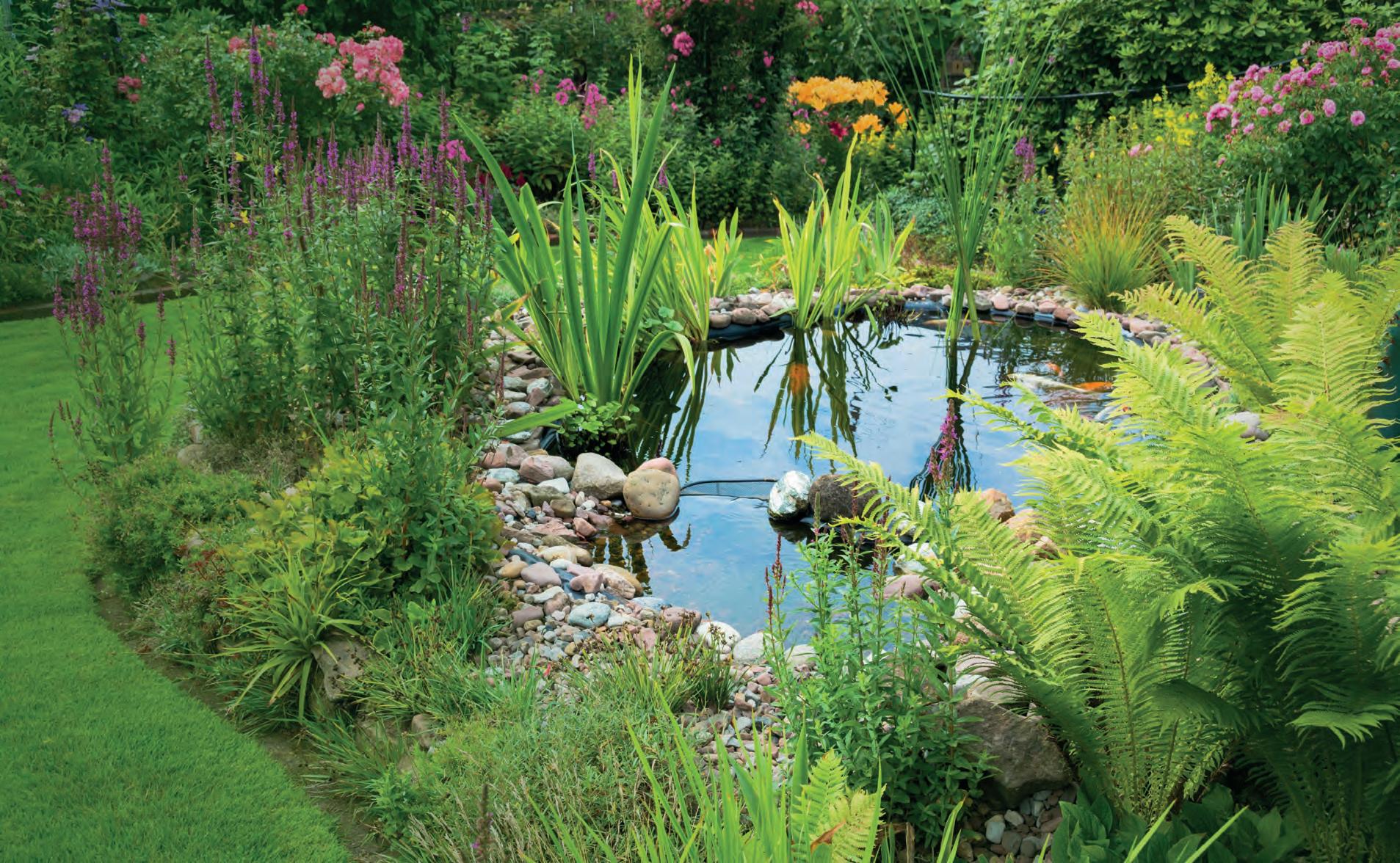










Canonteign Falls, renowned for its spectacular series of waterfalls, lakes, and ferns, is holding its second Plant Heritage Fern Day on Sunday 9th June. This special event will highlight the two National Collections of hardy ferns; dryopteris and polystichums.
Fern enthusiasts and nature lovers alike are invited to immerse themselves in the world of ferns at Canonteign Falls. The event will feature talks by Julian Reed, a fern specialist and member of the British Pteridological Society. Reed’s talks will take place against the backdrop of the Victorian Fern Garden, offering visitors valuable insights into the world of ferns.
Guests can visit the lakeside cafe, treat themselves to a cream tea and explore an array of plants available for sale at Canonteign Falls’ Plant Heritage Fern Day. Canonteign Falls has almost perfect conditions for growing ferns and many species grow naturally throughout the falls. Yet the existence of a rare and specially planted fern garden on the estate had been forgotten. Tucked away in a hanging valley the full extent of the garden wasn’t even discovered until 2009. The original hardy fern garden was created by Lady Susan Exmouth, wife of the 3rd Viscount. Lady Susan employed the estate’s redundant silver miners to build the paths and beds. Canonteign became a wonderful example of a Victorian fern garden - a jewel in a natural landscape of rocks, waterfalls, streams and ancient bluebell woods. But as the fortunes of the estate waned, the garden became overgrown and abandoned.
Attendance to the Fern Talks must be pre-booked. Opening times are 10am to 4pm, Normal admission prices apply and the fern talks are free.
For further information and to reserve your place for the talks, visit www.canonteignfalls.co.uk or call 01647 252434
Rose lovers really have one date in their diary for the next few weeks – the spectacular four weeks of the RHS Garden Rosemoor Festival of Roses. The hugely popular annual event opens on Saturday 15th June and runs through to Sunday 14th July. It is the chance for visitors to revel in the scent and sight of thousands of rose buds and blooms, a sensory celebration of summer.
Guests will be able to immerse themselves in the fragrance and spectacle of thousands of roses in bud and in bloom in two dedicated gardens at the north Devon gardens.
Brought to their peak by the ideal conditions, there is no better place to admire the breadth of colour, shape and habitat of these national favourites in early summer. It represents one of the UK’s largest collections of roses; Rosemoor is home to more than 200 different varieties and over 2,000 specimens, ranging from traditional cottage garden climbers to modern varieties, all planted in different settings and combinations in the heart of the garden.

Whether you are a gardener or not, it’s a sensory experience that is not to be missed! Visitors can join weekly walks or talk to the gardens advisory team to make the most of their visit. Or, join in on the Rose Weekend which runs from Friday, 21st June to Sunday 23rd June where you can also enjoy family entertainment and an artisan craft and food market. Normal garden prices apply and no booking is necessary.
RHS Rosemoor, Torrington EX38 8PH
“Spring being a tough act to follow; God created June” - Al Bernstein
“June is busting out all over” - Oscar Hammerstein GET
Leading wildlife charity, Butterfly Conservation, has revealed the dates of this year’s highly anticipated Big Butterfly Count, which will take place from 12th July to 4th August.
The annual programme attracts tens of thousands of people out into their garden, local green space or the countryside to spend 15 minutes counting butterflies and helping to inform conservation action.
Hot on the heels of scientific evidence that proves counting butterflies is good for your mental health and wellbeing, reducing anxiety by almost ten per-cent, the charity is calling on people to get out for the Count this summer.

Butterflies are indicators of a healthy natural environment, and with half of Britain’s butterfly species already threatened or near threatened with extinction, it’s never been more important to understand how our insects are responding to the changing climate and to take action to protect them.
Last year more than 135,000 counts took place up and down the country.
For more information and to take part simply visit www.bigbutterflycount.org or download the free Big Butterfly Count app.

Home improvement and gardening retailer B&Q are launching new recycling stations in more than 100 of its stores across the country where you’re able to simply drop off your no-longer-needed plastic plant pots. What’s more, the brand will then turn those collected planters into new ones, made exclusively with recycled plastic.
The retailer has made a big investment in its gardening section. And now those sustainability-conscious will be able to purchase planters made from recycled plastic plant pots collected from customers via its recycling stations specific garden centres have launched their own schemes but this initiative is the first from a large multiple store retailer.
To find out about participating stores go to www.diy.com
Canonteign Falls - perfect venue for fern day Two hundred varieties of roses will be on show
Your local Otter Garden Centres: OTTERY ST MARY Gosford Road, Ottery St Mary, EX11 1LZ PLYMOUTH Chittleburn Hill, Brixton, Plymouth, PL8 2BH JACK’S PATCH Newton Road, Bishopsteignton, Teignmouth, TQ14 9PN TORBAY Moles Lane, Paignton, TQ3 1SY Also find us at TAUNTON, WINCANTON & LYMINGTON www.ottergardencentres.com
Interesting and colourful gardens are opening in Devon for the National Garden Scheme in June, raising much needed funds for nursing and caring charities.
SOUTHCOMBE
BARN, Widecombein-the-Moor, Newton Abbot, Devon, TQ13 7TU opens for the National Garden Scheme on several dates in June: Thursday 6th, Friday 7th, Saturday 8th and Sunday 9th, then Thursday 13th, Friday 14th, Saturday 15th and Sunday 16th June, from 10am until 4pm each open day.

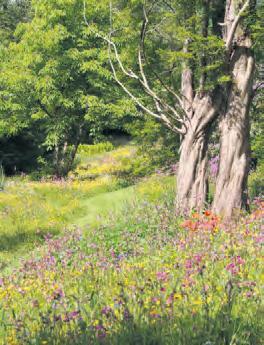
There are five acres to explore - vibrant wildflower meadows and flowering trees with mown grass paths running alongside a gently babbling stream; a new apothecary garden on the sheltered hillside with medicinal, dye, culinary, tea plants and herbs and now buzzing with new wildlife. Fresh herbal brews, teas and cakes will be served. Art exhibition will be open in the gallery. Admission £5, children free, homemade teas available, dogs allowed on short leads. Limited wheelchair access. This is a venue also offering accommodation.
PARRACOMBE GARDENS, Parracombe, Barnstaple, Devon, EX31 4QL open for the NGS on Saturday 22nd June, 12pm-5pm, in the historic Exmoor village of Parracombe, with its Norman motte and bailey castle and the ancient 12th century church of St Petrock’s, and the churchyard, managed by volunteers, set to become a County Wildlife Site. Charming cottage gardens, a developing orchard, and a garden with an elegant cobbled courtyard, herbaceous borders, and mature trees beside the river Heddon. Teas/ light lunches and WC at Pavilion Community Stores and Café. Combined admission £6, children free. Plants for sale and dogs allowed on short leads. Unsuitable for wheelchair users.
More gardens opening for charity on page 30
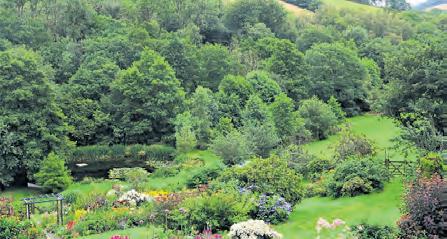
North Devon Hospice’s stunning gardens will open to the public on Saturday, June 1st with live music, barbeque and family activities.
The charity will be opening their gardens and children’s trail giving visitors the chance to see for themselves why these tranquil grounds are so loved by patients and families.
From 10am until 4pm, guests can explore the gardens and children’s trail for free before enjoying a full itinerary.
Donna Matthews, head of facilities at North Devon Hospice, said this was an opportunity to explore the hospice gardens at their best.
“If you haven’t visited our beautiful gardens before, now is your chance to do so,” she said. “We are proud to have created a serene environment for our patients and families, where they can go to feel at peace and reconnect with nature. It’s an absolute pleasure to be able to share this with our wonderful community. Any donations on the day will be greatly appreciated and will help us provide vital care now, in our 40th anniversary year”.
North Devon Hospice, Deer Park, Deer Park Road, Newport, Barnstaple EX32 OHU
On Saturday 29th June, Dartmouth & District Friends Group will be celebrating the 20th anniversary of their art and craft event in aid of Children’s Hospice South West. Dart Art Day will take place from 10am to 4pm in Royal Avenue Gardens and promises to be another lovely occasion to celebrate and support this incredible charity. The aim is to raise as much money as possible to help the charity to make the most of the short and precious lives of children not likely to reach adulthood - last year it raised over £3,300. Continuing the success of the one-day Dart Art Day, after 17 years as the Dartmouth Art Weekend, there is sure to be the same wonderful, friendly atmosphere with 22 artists and craft workers in their gazebos in Dartmouth’s Royal Avenue Gardens, with all their work available to buy. Stallholders are attending by invitation only due to limited numbers, giving better space for all.

As well as all the stalls with arts and crafts galore, there will be entertainment from a range of musical performers, balloon sculptures, CHSW tombolas, as well as teas, homemade cakes, cream teas and sandwiches provided by Children’s Hospice volunteers and supporters.
This event is an important fundraiser for Children’s Hospice South West to help the charity to continue to provide essential specialist care and support for over 550 families with life-limited children in the South West. The CHSW Dartmouth & District Friends Group meets monthly to organise events locally to raise money and awareness of this wonderful charity.
For more information or to offer help in any way, however little or infrequent, please contact Sue at tweed833@btinternet.com or on 07955197721.
The east Devon village of Southleigh has gardens open Sunday, 2nd June from noon to 5pm in aid of Seaton Hospice at Home and Southleigh Church. There’s tea and cake in the village hall and entry is £5 per person. Proceeds in aid of The Seaton Hospice.
Dry stone walling is back for the summer in Devon. It has become one of the most popular countryside skills and for people who love nature, the outdoors and getting their hands dirty it’s a chance to learn a new skill. You can spend a morning in a hands-on three-hour workshop learning the basic principles of how to build a traditional dry-stone wall using local stone. The hosts are Quince Honey Farm near South Molton and the cost is £50. The popularity of this rural skill is down to its positive and calming outdoor experience. The course covers preparation of ground quoins and repairs and construction techniques. The next course is on Saturday 8th June from 10am onwards.
Quince Honey Farm, Aller Cross, South Molton EX36 3RD


and requiring minimal attention. Nicky Davies sings their praises.
Fabulous – certainly. Colourful – definitely .Close to our hearts – always. Lilies are often brightly coloured and boldly fragrant and the flowers are a very glamorous addition to any garden where they can be grown in containers or combined with other flowers in the border.
Arising from plants made up of lose scales attached at the base, lily plants are diverse and the flowers vary enormously.
They are so variable in fact that they are classified into nine divisions depending on where their original parent species grow in the wild. These divisions help indicate to gardeners whether they are likely to be scented or not and what conditions they prefer.
However, as lilies hybridise so readily and have been cultivated for so long they can be hard to pin down to precise categories.
For most gardeners it’s best not to worry too much about classification and just enjoy those that you find grown well in the conditions you provide.
Everyone loves lilies! Grown from bulbs, lilies are perennials that require minimal care if planted correctly. Most lilies do well in containers and look spectacular in a vase.
True lilies belong to the genus Lilium and grow from plump, scaly bulbs. Several popular lily species exist, including orientals, asiatics, orienpets, and species types.
We say ‘true’ lilies because there are also plants, such as daylilies, peace lilies, and canna lilies, which have the term ‘lily’ in their common name, but they’re not actually lilies at all. They do not grow from bulbs but are in a different plant genus.
With 8,000 or so varieties, lilies parade an endless range of colours, shapes, heights, and bewitching scents. Lilies have six plain or strikingly marked tepals (“petals”) and are often trumpet-shaped, sitting atop a tall, erect stem with narrow, long, lanceshaped leaves. They come in many beautiful colours, including pink, gold, red, orange, and white.
Most lilies also take readily to containers at home in formal and naturalistic settings. Plus, they make excellent cut flowers!
To create a sequence of lily blooms in your garden, remember that Asiatics generally flower first, followed by Orienpets and then Oriental varieties.
• Asiatic lilies
Are the earliest to bloom (usually in May or June), right after peonies. They are also the easiest to grow, as long as they are planted in well-draining soil, not waterlogged. They are the shortest type of lily (about two feet tall) and come in many colours, from pastel to tropical. Hybrids come in pure white, pinks, vivid yellows, oranges, and reds; heights are from one to six feet. Intense breeding has erased much of the Asiatics’ fragrance, but despite their lack of perfume, they are a favourite with floral arrangers.
• Oriental lilies
Have that famously intoxicating fragrance. They are tall and stately (4 feet), and tend to grow more slowly. Oriental hybrids bloom in mid- to late summer, just when Asiatic lilies are beginning to fade. Orientals are always a striking choice, producing masses of huge white, pink, red, or bicolour blooms. They make wonderful cut flowers that fill even the largest rooms with spicy scents.
• Easter lilies
Are most commonly grown indoors as a holiday plant. As their name suggests, they are typically forced into bloom around Easter, in March or April.
• Trumpet lilies
Are similar to oriental lilies, producing many blooms with a nice scent. Their flowers tend to be smaller and more closed (like a trumpet) than those of the other lilies.
In the wild lilies can be found in a range of habitats, from rocky mountain crags to alpine meadows, wetlands to prairies and forests which leads to a range of supremely adaptable garden plants. In recent years they have seen an explosion of breeding and diversity and there are many new hybrids available. They originated from eastern Asia around 20 million years ago.
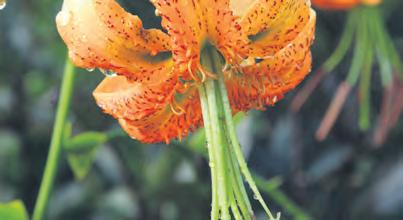

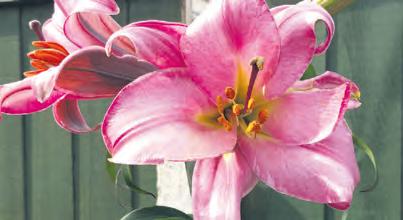
 Lilium Henryi was introduced to the west by Professor Augustine Henry who found it near the Yangtse River in 1888. Reliable and fast growing it enjoys limy soil and can reach two metres in height.
L. ‘Casa Blanca’ this lily has huge white scented flowers around 10cms across with a hint of green at the bottom of the bloom. It flowers from July to August.
L. ‘Pink Perfection’ a relative newcomer introduced in the 1960’s this is a magnificent cultivar which can grow up to 2metres tall- a lavender pink which flowers in July.
L. martagon unusual in that it favours shaded woodland and had neat speckled flowers slightly scented.
Lilium Henryi was introduced to the west by Professor Augustine Henry who found it near the Yangtse River in 1888. Reliable and fast growing it enjoys limy soil and can reach two metres in height.
L. ‘Casa Blanca’ this lily has huge white scented flowers around 10cms across with a hint of green at the bottom of the bloom. It flowers from July to August.
L. ‘Pink Perfection’ a relative newcomer introduced in the 1960’s this is a magnificent cultivar which can grow up to 2metres tall- a lavender pink which flowers in July.
L. martagon unusual in that it favours shaded woodland and had neat speckled flowers slightly scented.



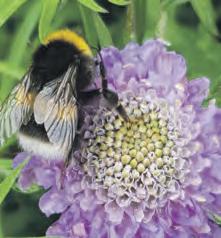
Loddiswell Kingsbridge Devon www.avonmill.com 01548 550338 Lovely Café serving Fabulous Breakfasts, Lunches & Devon Cream Teas Parking • Woodland walks • Dogs welcome

Perennials 9cm pots 4 for £10 Summer Basket & Bedding Plants Available Now
Selection of Trees, Shrubs, Fruit, Roses, Perennials, Alpines, Seeds & more... Help Advice & Friendly Service Check our website for details or find us on Facebook! www.covegardennursery.co.uk Tel: 01398 331946

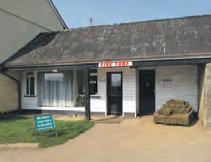
WE SUPPLY LOCALLY SEEDED TURF, TOPSOIL, COMPOSTS (MUSHROOM/ORGANIC GREEN WASTE) AND LANDSCAPING BARK, WHICH WE CAN DELIVER OR YOU ARE WELCOME TO COLLECT.
the A396, Cove, Tiverton EX16 7RU

Bridford, Nr Exeter EX6 7LB 01647 252654 Traditional Nursery Trees, Shrubs,Climbers and Perennials Hanging Baskets, Patio and Vegetable Plants Garden Shop, Local Produce Competitive Prices www.teignvalleynursery.co.uk teignvalleynursery@gmail.com


01364 652538 Lower Waye Farm, Ashburton
Lower Waye Farm, Ashburton TQ13 7ET TEL: 01364 652538
EMAIL: fineturfdevon@gmail.com
WEBSITE: turfdevon.co.uk









Mark Bourne is a counsellor in the Hampshire area who puts great store in the benefits of gardening, plants, trees and green spaces and he shares the way it can improve anxiety, anger and bereavement
What is the best way to eliminate such mental health concerns such as anxiety, bereavement or depression? Is there a key element to live a mentally fit life?
Is the answer solely gardening or walking in open spaces?
Now don’t get me wrong, I am not saying that there is one case fits all. Nor am I saying that taking a walk in the park or tackling the plants and weeds in your garden will solve all the problems.
If it was as simple as that I would be out of a job! However, these things can certainly go some way to aiding a lot of mental health problems and help to maintain a healthy lifestyle.
As a counsellor, I know such matters as anxiety or bereavement are complex and often very serious mental health complaints. These often require trying lots of different strategies to find what is the right solution for you.
It is fair to say that these sometimes take a long time.
However, I firmly believe working with nature be it by gardening or just strolling in an open space can represent part of the cure and can lead to you having a healthier lifestyle.
What I like about this sort of thing is that it can be a constant in your life wherever you are and whatever you are facing in life. It is fairly easy to access and it is something that you can do alone, as part of a group, or both depending on your feelings in a week.
The gardening and open spaces provide a chance for us all to get more active and provide greater balance to our lives. These can also allow us time to provide some of the answers in our lives in a very busy, often complicated and stressful world.
There are lots of evidence both medically and psychologically that some form of getting outside is good if you suffer from anxiety, anger or bereavement.
A fellow counsellor said to me recently that they must get some freedom from the constraints of a normal week. The freedom is represented by quiet places, birds and nature. Indeed, there are lots of counsellors who provide walking counselling, so it is possible to achieve two things in one.
I personally have always believed in getting out in the garden or walking as much as I can. I have felt a release from the constraints of life, both mentally and physically.
When taking part in these things, my chest is under less pressure, I breathe much deeper and my frown lines become less!
I find gardening can be a good method of exercising and leave you feeling better for having achieved something. I think there are people who agree with that, if the number of people cutting their grass at the start of March despite the torrential rain, is anything to go by! When completing the gardening and without realising it, I will have been allowing my brain time and space to go over problems in my mind at that time.
Carl Rogers was an American counsellor and inventor of the Person-Centred counselling modality. He believed that all of the problems that a person encounters in their lives could be resolved with answers which already existed within that person’s mind and thought process. His theory was that if the correct climate and relationship was present then the true potential that everybody possesses was possible.
Rogers appeared to be close to nature all of his life.
He looked after animals and for the majority of his life, carried out gardening. When I was studying him for my counselling qualification, I could see a definite link between the soil, plants, relationships and human beings. As though his mental wellbeing ran alongside nature and what he did at work was as a result of this.
Wellbeing magazine articles seem to suggest the following: eating healthily, exercising, sleeping well, drinking enough water and a lack of alcohol and smoking. All of these seem to be included to encapsulate a more natural life. Maybe it is time to take up gardening as a hobby, to make that walk a more consistent thing in your life. Who could blame you in the glorious spring/summer weather.
I am hoping for the weather to play its part, fingers crossed eh?
One way of getting revenge on unwanted weeds is to use them to feed your own plants
Making fertiliser is just about the most eco-friendly way to save money and benefit your garden. It reduces dependence on commercial products altogether.
Any plant material when left to decay will release its stored nutrients (just think of compost heaps). However, by steeping the material in water these nutrients are leached directly into liquid taking on a soluble form that is easily available to other plants. Homemade mixtures can be variable so just be careful the finished food is not too strong.
Plants, like people, do best when they have good nutrition. They take this from the soil they grow in.
There a number of ways we can help boost the nutritional level of soil. This includes having good-quality compost as part of the soil (you can also try making your own), as well as adding a layer of mulch each year.
Liquid feeds provide some of the nutrients most important to plant growth:
• Nitrogen (N) stimulates leaf growth
• Potassium (K) or potash promotes developing flowers and fruit
• Phosphorus (P) enhances root growth
Too much use of plant food or fertiliser can be harmful for plants and the soil. It’s better to use too little than too much.
There are a few plants that can be used to make liquid plant food. Here, we look at the three most common:
1. Comfrey
Comfrey has the highest level of nutrition. If you grow it in your garden, it will provide endless amounts of feed over many years of growth. Comfrey is rich in potassium and good for fruit, vegetables and plants that have big shows of flowers.
2. Nettle
Nettle is high in nitrogen and good for herbs, shrubs and leaf vegetables, particularly brassicas. The challenge may be collecting it, as many people don’t like to cultivate nettles in their own gardens. Don’t pick nettles from wildlife or nature reserves, as this may disturb wildlife habitats. It’s a good idea to check with the landowner if you are thinking of picking from another public or private space.
3. Dandelion
With dandelions, you make the feed using the root as well as the stem and leaves. This creates more micronutrients such as magnesium and iron, which are important in plant growth.As with nettles, not everyone likes cultivating dandelions in their garden. Perhaps you will come around to growing them if they are a source of homemade plant food!
WHICH PLANTS TO GIVE LIQUID FEED TO
Most of the plants in our garden will benefit from a liquid feed, including flowers and food produce.
Houseplants can have slightly different nutritional needs, but they will still benefit from your homemade plant food.

1. Harvest about one kg of comfrey leaves with secateurs. There isn’t an exact science to how much plant material you need. The more you use, the stronger the feed will be.
2. Roughly chop the leaves and cover with 15litres of water and just leave to steep for six weeks. Add water to the bucket, almost to the top. If you have rainwater available, from a water butt for example, this is ideal.
3. Discard the leaves then use the liquid neat around your plants to give them a real boost. Put the lid on your bucket or container, or place something across the top that will cover it.
Leave your feed for four to six weeks. Check and stir occasionally. Look to see if it is bubbling. This is a sign that it is fermenting (breaking down / changing).
Once it has stopped bubbling, or the water has turned darker in colour, it is ready to use.

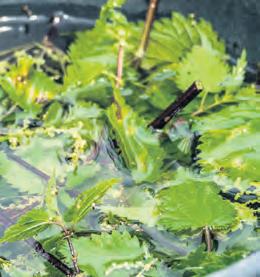

Kenwith Castle offer gardens and gardening as part of the way of life keeping residents happy, healthy and active.
The joy of gardening is universal and has no age limit, which is why Devon’s Kenwith Castle care home in Bideford has an expansive garden for the residents to continue pursuing their passion.
Getting outdoors has a host of benefits for our mental and physical health, so the residents enjoy planting bulbs and sowing seeds year-round. The activities team at Kenwith Castle organise a range of clubs and sessions to bring the residents together to share their love of gardening to keep them happy, healthy and active.
The residents have formed a gardening club where they get together to grow their own flowers, fruit and vegetables
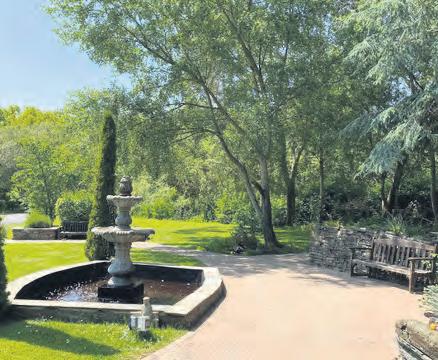
in colourful pots and planters. A team of gardeners do all the general maintenance of the garden, meaning that residents can spend their time doing the bits they enjoy, with none of the gardening chores, like weeding and cutting the grass, tied in.
Gardening has a host of mental and physical benefits for everyone but it’s particularly beneficial as we get older. These include:
• Gardening involves a manageable amount of exercise – walking around the garden, digging the soil and sowing seeds, and watering plants
• Improved mobility – engaging in gardening requires some bending, reaching and stretching which can help improve flexibility and mobility
• Getting outdoors boosts Vitamin D levels helping to maintain healthy bones as well as being a great mood booster
• Social opportunities to connect with family and friends while chatting over shared interests
• Sense of accomplishment - the wonderful feeling of successfully growing plants, flowers, fruit and vegetables provides a huge boost to self-esteem and confidence
The garden at Kenwith Castle has been designed to offer a sensory space for people living with dementia or sensory impairment. Scents from sweet peas, lavender and roses can stimulate memories, while touch can be stimulated through tree barks and grasses, and the residents can listen to host of noises from bees and birds who visit the garden.
The care home benefits from wider landscaped grounds featuring a picturesque lake with stunning countryside views offering a place for a moment of reflection.
The garden features wide, flat walkways and raised flower beds to make them accessible to everyone, with plenty of outdoor seating areas and benches to enjoy some quiet time. It’s also the perfect setting for the residents to enjoy a host of garden parties and barbecues to make the most of the sunnier weather, with friends and family always encouraged to join in the fun.
The grounds are also home to assisted-living bungalows, Kenwith Castle Gardens and Kenwith Meadows, as well as Kenwith Pavilion Shop & Cafe, which opened towards the end of last year for the exclusive use of the residents within the care village. The shop is stocked with a host of everyday essentials, cards and gifts, while the cafe offers a meeting place for residents to get together over coffee and cake. It will also play host to a range of events including coffee mornings, afternoon teas, monthly Sunday roasts, quiz nights and games afternoons.
Kenwith Castle, which is part of the not-for-profit charity, Care South, provides specialist residential, respite, and dementia care. It features a dedicated activities team who organise a daily programme of events to bring residents together to socialise and build friendships.
The care home features individual rooms for residents which benefit from several large communal lounges overlooking the landscaped gardens and lake offering peace and tranquillity.
Come and experience the beautiful lake, grounds, and atmosphere within the care village at Kenwith Castle’s open day on Saturday, 22nd June from 10am to 2pm. All are welcome to attend.
KENWITH CASTLE, ABBOTSHAM, BIDEFORD EX39 5BE





it


The British lawn has come a long wayfrom rough scything to wonderful 19th century mowing contraptions, to perfectly striped swathes and now to the trend led by No Mow May to let the grass grow and nature take over
Our idea of the perfect lawn has changed- and changed dramatically.
No Mow May, the hugely successful initiative from conservation charity Plantlife has encouraged us to see what happens when we put the mower away for a month. Few gardeners now would miss the opportunity of seeing what strange flowers and wonderful weeds and plants lie waiting to appear in growing grass.
Of course, the high maintenance perfect lawn with its roller stripes and regime of cut - feed - cut - feed throughout the spring and summer is still on our landscape and will never disappear. Yet that too has been challenged by hot summers and the cost of fertilisers needed to maintain that perfect green look. All this perhaps raises question marks over how we might treat our lawns to be less lush than we are used to. We don’t need large lawns and one of the trends gardeners are becoming more aware of is cutting back on the size of their grassed areas and creating more space for borders, shrubs and general new planting areas. It is a significant change as managed lawns have always been a component in British gardens.
The first lawns were likely village greens or town commons, found throughout Europe in the Middle Ages. The citizens of the village had the right to graze their cows, sheep, horses, etc. on this communal pasture. The constant grazing produced a very short meadow which was called lawn, from the Middle English launde, for glade or opening in the woods.
The aristocracy adopted a similar green space around their castles: again, one simply maintained by grazing animals. The idea at the time was said to show that the owner was a good Christian (a reminder of the many references to sheep, shepherds and pastures in the bible), but in this period of almost constant war, a grassy space free of tall vegetation also let you see the enemy coming from afar.
They were established as an indispensable element of garden design during the 18th century. Then landscape designers stylised English pastoral scenery – by far the most prominent surface treatment in their idiom was cropped grass. Beyond the ha-ha, sheep cattle or deer may have maintained the sward. But next to the house, it was required that men with scythes regularly trim the herbage, an extremely labour intensive and skilled task. The aesthetic demanded as smooth a surface as possible.
“Few gardeners now would miss the opportunity of seeing what strange flowers and wonderful plants lie in long growing grass.”
This meant that only a relatively small area of grass was kept short near the house. It was of course the lawn mower which changed everything. Edwin Beard Budding patented his device in 1830, adapting it from the cutting cylinders used by fabric mills to trim the nap from cloth. At ten guineas ( probably £10,000 pounds in today’s money) the cost of Budding’s machine was high and it wasn’t until after his patent expired in 1855 than other companies piled in with, yes, some weird and wonderful designs but it brought in the age of the lawnmower. It is no great coincidence that the following decade
saw the birth of grass sports in their modern context with the first British Open held in 1860, the Football Association formed in 1863 and tennis taking off in the 1870’s.
The mower swept over Britain first pushed by man, then by horse, then briefly by steam then petrol, plug socket and finally perhaps battery powered robots.
When you consider that grass was predominantly a resource for feeding livestock, the notion of constantly employing men to remove it can be considered an outrageous act. The modern history of the lawn can be said to really get going during this period when lawnmowing technology moved at a fast pace.
But it is important to remember that the earliest lawns were very much the preserve of the elite.
Lawns have held a powerful aspirational appeal ever since Budding’s machine appeared was invented in Gloucestershire in the 1830s, almost as a by-product of the industrial revolution in cloth-making. The technology was essentially sound but the quality of the finished lawn varied enormously and though initially somewhat cumbersome to use, and it was adopted fully with some modifications over the course of a few decades.
This gradually democratised the ownership of lawns in concert with the development of suburbia. Would this lessen the allure? The new technology meant, lawn maintenance remained an aspirational activity even for those who had to perform the labour themselves. Lawn mowing machines and accoutrements became status symbols in themselves.
When André Le Nôtre designed the gardens of Versailles for Louis XIV at the end of the 17th century, launching the jardin à la française (French formal garden), he included a vast “green carpet” (also called “Royal Alley”), a parterre of vegetation kept mown by gardeners with scythes and located on the garden’s main axis. This was probably one of the first strictly ornamental lawns in history.
The cool, humid climate of Western Europe made such an innovation possible. It would be difficult to imagine lawns having evolved in the hot, arid climates of Mesopotamia or Egypt.
Soon such “green carpets” began to spread all over Europe along with the French formal style, because nobles wanted to imitate the Sun King.
But the reign of the French formal garden—highly geometric and dominated by precisely trimmed hedges, designed to show the total domination of man over nature—was actually short-lived. It was almost wiped off the map less than a century later with the arrival of the English landscape garden, under the influence of English designer ‘Capability’ Brown (1716–1744).
The English landscape garden is characterised by a bucolic landscape dominated by a green lawn. Stourhead, the National Trust property in Wiltshire is perhaps a classic example.
This style offers a return to a more natural look, a rediscovery of nature … but of nature as improved by human hands. Brown designed sweeping pastoral

“The mower swept over Britain - first pushed by man, then by horse then briefly by steam then petrol, plug socket and finally perhaps battery powered robots.”
landscapes marked by artificial hills, asymmetrically shaped lakes, serpentine streams, seemingly natural groves, etc. Connecting all these elements was an undulating green lawn. Maintenance is still mainly done by the cattle and sheep, which were prevented from wandering into the manor house by “ha-has”, ditches specially designed to appear invisible from a distance. But with the arrival of the first lawn mowers, timidly in the 1830s, but especially from 1860 on, first the gentry, then the middle class took the style for themselves. Now there was no need to hire teams of peasants wielding scythes, one man could mow a vast lawn over just a few days.
So, the price of maintaining a lawn dropped considerably. Not only could the castles and manors of the landed gentry have vast lawns, but simple country homes as well.
By the Victorian era, even as the lawn was taking over


upper-class abodes, lawn sports—croquet, tennis, lawn bowling and polo —were also becoming popular and they required flat grassy surfaces. Yet another reason to put in a lawn!
In fact, the perfect lawn started to become an ambition. In 1895 Samuel Parsons wondered that having a poor lawn was as inexcusable as a soiled carpet. The striped lawn in all its perfect shades was starting to appeal to gardeners - the pattern created by the lawns’ heavy roller which pushed the grass sidewards allowing one strip to bounce light from its blades while the next shows dark, shadow casting tips.
Lawn striping is still an additive pursuit and is never likely to disappear. The fascination now borne on the back of No Mow May is what happens to grass when it is left untreated and it might easily contain yarrow, buttercup, moss, vetch celandine and common daisies and buttercups. Each grows at a different rate giving the growing grass a wonderfully abstract texture.
Many now argue that leaving grass long is a trend which will last and that combined with the desire to let borders invade the lawn we are doing away with the need for cutting the grass.
But reports of the lawn’s death are exaggerated and there will always be the need for play and picnic areas but perhaps it is the size of our lawns which are being cast aside. But whatever the future the traditional English lawn continues to be in an age of change.

The number of queries and questions from readers continues to arrive at Country Gardener and we are delighted to hopefully be able to answer your concerns and gardening problems. Email editorial@countrygardener.co.uk
I would like to grow some bamboo in my newish Devon garden but I guess I have been put off by all the coverage of how invasive bamboo is. Are there any safer varieties for me to try?
Andy Trenchant Poole
Yes, there are some great varieties to try, and early summer is a great time to plant them. Let’s get the bamboo ‘nasties ‘out of the way. This is the running species which once established can be invasive and difficult to control, producing long underground arms before shooting out 20 ft high canes. You need to rather focus on the clump forming species which are still fast growing but can be far more easily contained Here’s two options: Chusquea culeou forms broad dense clumps of olive-green stems covered with short sprays of narrow mid green leaves giving it the common name ‘foxtail bamboo’. It will grow to about two metres. Fargesia nitida is another plant forming a dense clump of deep green canes varying from upright to arched poles turning purple with age, good for windbreaks and needs to be controlled down to three metres in height.

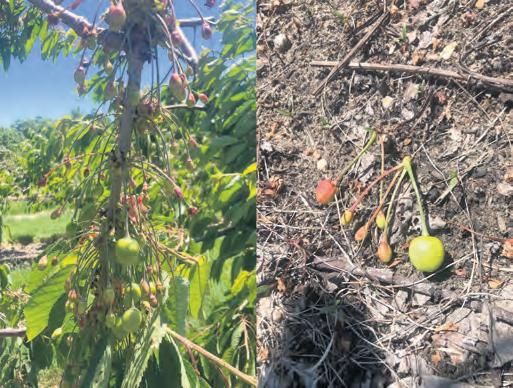
My much loved three cherry trees regularly lose most of their fruit in early summer. This is so upsetting. Are they diseased and is it a permanent problem or is there a remedy?
John Davies IlminsterThis loss is called cherry fruit drop or run off and, in severe cases, it can lead to an almost total failure of the crop. Many members of the Prunus group, such as apricots and almonds, shed fruit that they do not have resources to bear. This fruit drop can severely reduce the harvest. In Britain, the most common fruit to suffer is the sweet cherry and this is referred to as cherry run off. Pruning trees to give an open canopy is one potential remedy. This maximises light to the leaves, and thereby increases the photosynthetic rate, so is likely to minimise fruit drop. You can also reduce the number of fruits when there are more than ten fruitlets per spur, to help matters. Carry out this task when the fruitlets are less than five mm (¼in) in diameter – usually when petals are still present and before the pit hardens.Thinning the cherries will create a balance between the supporting leafarea and the fruit, increasing fruit retention.
I appreciate the principles of rotation planting -moving crops around season by season but I have a very small garden and vegetable plot and it isn’t always possible.
Valerie Stripley LissIt doesn’t really matter how big your plot is . You must just avoid planting the same crop in the same place for a couple of years. It creates disease.
There are three main groups of veg, and each group, once grown in the garden, shouldn’t be grown in the same place again for a couple of years.
Group one is roots:Beetroot, carrots, kohl rabi, potatoes, turnips, swedes.
Group two is legumes: Leeks, lettuces, beans, peas, leeks, onions, shallots and radish.
Group three is brassicas :Cabbage, cauliflower, Brussels sprouts, broccoli, kale and spinach.
Perennial veg, like asparagus, globe artichokes and rhubarb, does not need to be rotated. They can stay in the same bed for many years.
I love growing different varieties of squashes and pumpkins, but I seem to struggle to get them going in early summer and consequently they are not always the biggest fruit. And often disappointing come the autumn. Are there any tricks which might help?
Peter Gullig Minehead
You need to be selecting the right variety to grow obviously but these are very hungry and fast-growing plants and need a lot of feeding in their early days with a general all-purpose liquid feed -probably very day or two when the leaves start to appear. Starting the crop off indoors is also another great help and keep them under cover for as long as is sensible. This also protects them from slugs and snails. Finally give them plenty of room. If you are growing in one spot make sure the plants are at least 40 cms apart.



I would love to grow bee-loving hebes in my garden but have been told they can be difficult?
Harri Porter Exeter
There is nothing which should worry you about growing them. Hebes are popular evergreen shrubs, mostly native to New Zealand although some are native to Australia and South America. They come in a wide variety of shapes and sizes, and are excellent in shrub borders, used as ground cover or lowgrowing hedging, and are relatively low-maintenance.Hebes flower over a long period – all year round in mild regions –with flower colours including pink, blue and white. You are right, they can be an important late-year source of nectar and pollen for bumblebees.
Hebes are native to scrubland and, as such, are tough plants, however, they do need protection from cold winter winds. Choose a sheltered spot such as in front of a south- or westfacing wall. Hebes are tolerant of poor soils so will grow virtually anywhere. Larger cultivars can be grown at the back of a border while smaller varieties can be grown towards the front, or in pots. Most thrive in moist but free-draining soil in full sun to partial shade, ideally in a sheltered spot protected from winds. They don’t need rich soils and will tolerate drought.


It has been a bad spring for us with rats and quite a few of them nesting under the decking in the garden and being very prominent throughout the garden and often quite close to the house. There’s a long wait to get pest control out to deal with it so we are just looking for some ideas to help.
Michela Davies PetersfieldRats are unwelcome visitors and common-sense actions might help. Like all living things, rats need food, water and shelter to survive. Remove at least one of these from your garden and they are less likely to stay. Rats feed on grain and may be attracted to your garden by fallen food from bird feeders. Stop feeding birds. Store bird and other animal food in secure containers. Tidy gardens are less likely to attract rats as they provide less cover. Keep grass short, clear cluttered storage areas, remove rubbish and reduce overgrown areas, especially near fences or garden buildings. Rats are ‘neo-phobic’, which means they have a fear of new things. They don’t like disruption to their territory, so place obstacles in their runs and move things around in the garden frequently.
My greenhouse has been full of whitefly for the past two years. They suddenly appear and cause such a lot of problems that the tomato and cucumber crop has been decimated. Is there a long term strategy I can use to rid them permanently.
Baz Cornish MartockThe first thing is to clean the greenhouse really carefully. This might mean taking everything out, all the plants, everything. You need to get rid of anything that might have overwintered, things like red spider mite and white fly. Basil is a really good companion plant because if you’re going to get whitefly it loves basil so much it tends to go for it first and then, it’s a bit of a shame, but you can just take out the basil and get rid of the whitefly.So companion planting is really important, having a clean environment is very important, and the third and final thing is biological control. If you look on the plants what you’ll see is these little medallions, paper medallions and these arrive in the post, it’s the encarsia wasp. They’re almost so tiny you don’t even notice them, but they will eat the aphid larvae and really keep on top of it.

I would like to change the structure of the soil in my garden to allow me to grow ericaceous plants such as camellias, blueberries, heathers and rhododendrons. Is this possible?
Kevin Dawes BristolAcidifying garden soil will lower its pH so that ericaceous plants can grow. It is usually only required if your garden soil pH is neutral or alkaline. Sulphur is the most common acidifying material. Soil-acidifying materials can be applied at any time of the year, but products containing sulphur take longer to work when the soil is cold so are normally best applied from spring to autumn. Before adding any acidifying materials you need to check your soil pH to see how much (if any) you need to add. Soil with a pH of 7 is neutral, an acid soil has a lower value, and an alkaline soil has a higher one. Most plants grow best in soil that’s within a specific pH range, so it’s useful to know your soil’s pH.
I have spent a lot of money over the past few years to develop what was a lovely display of about five varieties of agapanthus. Shockingly they have become deformed and discoloured. This process started in April and has got worse and has affected the whole display. I haven’t seen it before and for many years my plants have been very healthy.
Your plants have been damaged by agapanthus gall midge which is a fly that can cause buds to become deformed and discoloured and fail to flower. It was first noticed in the UK in 2014 but may have been present for several years so this is very much a new problem for owners. The feeding activities of the larvae inside the buds cause abnormal bud development and affected buds usually fail to open. As the name suggests many species feed as larvae within plant tissues causing galling and distortion. Some are however, predatory on aphids and mites whilst others feed on rust fungi. Affected flower buds are deformed in shape and may have patches of brown discolouration. You must destroy badly infested plants and re-pot container grown plants, replacing growing media to remove pupating or overwintering larvae.

In the past few seasons my tomatoes have started off healthy but then become poorly with many of the lower leaves turning yellow with the veins staying green. Is this over watering again?
Robin Mallet BarnstapleNo, it sounds classically like magnesium deficiency and is often caused by overfeeding with potassium rich tomato fertilisers. You should be able to correct things by switching to a balanced plant food and /or apply Epsom salts as a foliar feed in summer.
I have a small Dorset garden and the only way I can really enjoy growing things from vegetables to shrubs to climbers is to use containers. However, my track record is not good and I wouldn’t say that my efforts to grow things in containers has been very successful. So, help!
Christine Bellows BridportThe most important thing about container gardening is to realise that the need to water your pots is far greater than in a normal garden. This is often the reason most container growing fails. The plants dry out far more quickly. Also you will need to make sure you get the compost you use right for the plants. Any errors with the wrong compost will be made worse in the container.For successful summer displays, choose plants that flower over a long period of time, respond well to deadheading and are tolerant of container cultivation. A wide range of suitable plants should be available in most garden centres from now.
The mainstay of summer containers are tender perennials, often referred to as ‘patio plants’. Those such as fuchsia can overwintered in the greenhouse as plants. Annual bedding plants are also good candidates and include nasturtium and pot marigold. It is possible to use hardy perennial plants, such as lavender, which can eventually be planted out in the garden. Choose a focal plant such as a structural shrub or annual climber grown on a small tripod for the centre of the scheme.
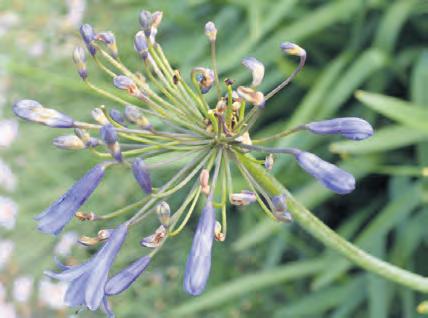

I travel a lot in my work and my wife is not a keen gardener. This often means problems watering plants in hot weather. I am considering investing in a seep hose irrigation system, but they run to several hundred pounds and I would like some advice as to if they are value for money.
Ian Cotton Burnham-on-Sea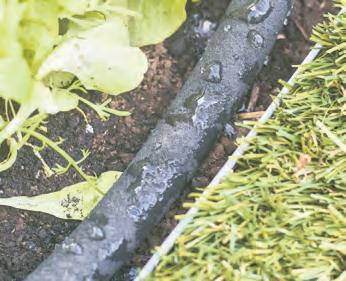
These irrigation systems are especially useful when used with a timer set for early morning to irrigate vulnerable plants. The systems position pipes so water seeps out slowly near the roots to keep them well hydrated. Watering the soil not the foliage puts the water directly where it is needed most. Your costs sounds expensive but the systems are increasingly popular in larger nurseries and growing greenhouses so it just depends how big a watering system you plan to introduce.
June brings with it several things. Perhaps nothing more certain than more daylight hours and more chances to be out working in the garden. It is also one of the months when things are growing at such a pace that your average gardener probably can’t cope. He and she needs some help. The borders need tending and planting, the soil needs its annual boost and already plants, shrubs and vegetables need the all-important garden supports. For many gardeners it is the most popular month of the year – and one of the busiest. So, a few garden accessories can come in handy.
It’s important to get some help. There are so many products lined up now to take off the hard physical work in the garden that most of us would be crazy not to seek help. We are always on the look out for great products and fresh ideas so here’s a few to help take the strain and make the garden even more enjoyable and your home more pleasureable.
Dovetail Greenhouses is a second-generation family firm based in Tamworth, Staffordshire and serving the entire mainland UK. They were established in 1993 and since that time have evolved from offering a fixed range of quality standard buildings to specialising in the bespoke market.
Dovetail greenhouses are hand-made from their own heavy duty aluminium profiles to fit the exact requirements of each individual customer.
This approach allows them to replace an existing timber greenhouse without disturbing the original base or to design and build a new greenhouse into a very particular location.

For a personalised quotation contact Dovetail Greenhouses on 0121 3112900


You can control your shrubs and climbers using Rivelin Glen Products uniquely designed Wire Anchors. They are quick and easy to attach to concrete posts (without drilling) to act as an ‘eye’ by threading wire through them to create a trellising system.
The Gripple Trellising System is ideal to use with the anchors as the wire does not stretch, takes up to 100kg load and has a life of up to 15 years. Multiple rows can be achieved with one length of wire and two tensioners. No more sore hands or sagging wires!
Rivelin Glen Products are the main stockists of the Gripple Trellising System.
Prices: Wire Anchors from £10.00 for a pack of three; Gripple Starter Kit - £19.75
Details available at: www.rivelinglenproducts.com Email: info@rivelinglenproducts.co.uk or Tel: 01246 462666

High quality, extra strong greenhouses, individually designed and custom-built to suit your growing needs
The ergonomic and functional OneLeg stool, with simplistic and clean lines enables you to sit rather than kneel, when completing low-level tasks around the home and garden. Its rounded base provides a natural ability to rock and tilt as you sit, increasing your reach as you tilt forward, improves your core and saves you from developing a painful back and knees when gardening.
Weather proof, impact resistant, lightweight, easy to clean and 100 per-cent recyclable, the stool comes in a great choice of colours and two heights, with a free black silicone anti-slip foot. Add a seat cover for extra comfort.
Once you have one you may wonder how you ever lived without a OneLeg.
This is a typical satisfied customer:“A game changer! What a brilliant little stool. Can’t wait for gardening to start with a vengeance!”
Tel: 0800 195 4252 www.oneleg.co.uk oneleginfo@oneleg.co.uk


Organic certified All in One fertiliser
Promotes strong root growth, thicker cell walls and prolific flowering
Perfect for saplings, vegetables, annuals, perennials, and houseplants! Give your plants protection naturally against pests, disease and drought!

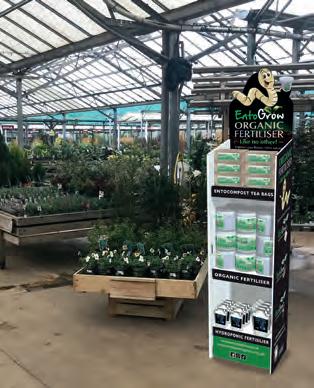
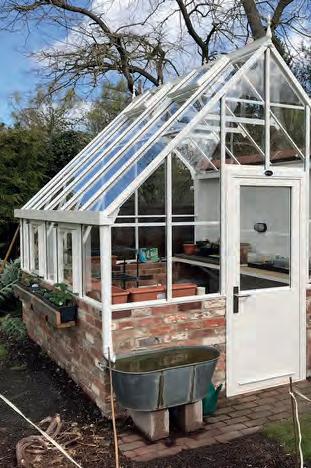


















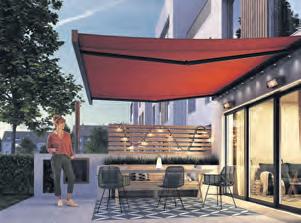
The new Amalfi Electric Awning from Eden allows you to enjoy alfresco evenings with dimmable lighting. Even better, the Amalfi is available with a finance deal – Buy Now, Pay later plus you can save up to 25 per cent off* in a Spring Sale. Constructed from the highest quality materials and bespoke manufactured, an Eden Awning is a stunning addition to any home. With optional accessories such as intelligent heating, lighting & controls to suit all needs you can spend more time ‘outdoors’ in comfort. Every Eden Awning is powder coated with a hard-wearing weather-proof finish, available in a choice of 150 RAL colours and 170 Fabric choices and installed by their engineers. To benefit from these offers, visit edenverandas.co.uk or call 0800 157 1677 and use code CG280524.
*Terms & Conditions apply, see website for details. www.edenverandas.co.uk
‘EntoGrow’ organic fertiliser comes from a Sustainable Award-winning business, recognised for their low carbon methods and organic supply chain. Their fertiliser is pure filtered sand textured mealworm excrement and can be used for top-dressing, root drenching or adding to potting mix to encourage a free-flow of nutrients for your plants, whatever they are. Emma and Mike breed mealworms as an alternative protein source for pet food and for people who feed garden birds, poultry, reptiles and fish. enquiries@entogrow.co.uk www.entogrow.co.uk
Tel: 079076 911983

A prolonged spell of extreme weather conditions has caused plants and especially fruit trees to be damaged by climate stress so you may need to act
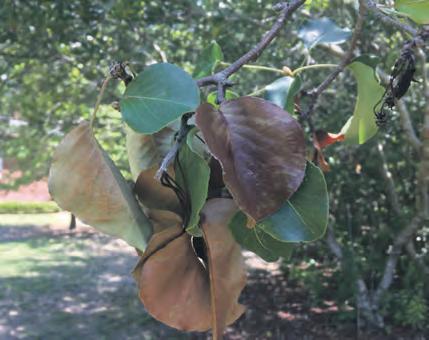
An amazing ‘mixing bowl’ of weather over the past 18 months which has included drought, high temperatures, storms and heavy prolonged raid has led to record cases of disease in young trees and fruit trees caused by climate stress.
Extreme weather conditions brought about by climate change cause plants to be stressed and more susceptible to problems.
Fruit trees are some of the worst to be affected. Nine of the top 11 diseases which have the ability to impact fruit crops, cause defoliation and even plant death all stem from weather conditions.
The ranking of disease is again this year topped by honey fungus which has taken top spot every year since the list was first produced in 1995, reflecting the large number of plants the disease affects. Weather helps define the state of our atmosphere – think hot, cold, rainy, dry, etc. Like us, trees have their own preferred range of environmental conditions and when pushed outside their comfort zone by weather, they can become stressed. Frequent weather changes and prolonged periods of extreme weather (e.g. a heatwave) can create new or worsen existing stresses for a tree, as well as impact its ability to adapt to and resist potential threats (pests, diseases). Here are the top stress-inducing weather events and how you can protect your tree against them.






Stockists of Gripple Trellising

Extreme heat and drought conditions

Heatwaves pave the way for drought conditions and when trees lack water, many areas of their growth and development are impacted. Symptoms that show your tree is lacking water include early fall colour, leaf drop, browning along the leaf edges, and wilting leaves. To protect any tree during extended periods of heat, be sure to provide regular watering (approximately six gallons per tree, two to three times a week) and mulch, which will help retain water and protect roots.
www.rivelinglenproducts.co.uk
info@rivelinglenproducts.co.uk
01246 462666
resiliency by selecting a native tree that has evolved to the local climate.
An abundance of rain can oversaturate soil and reduce oxygen available for tree roots, leaving the tree with symptoms of wilting leaves, browning, leaf drop and even fungal diseases such as powdery mildew. So, when the forecast calls for extended periods of rain, be careful not over water your tree. Always check the moisture levels in the soil around your tree before watering. To do this, stick your finger into the soil around the base of your tree – if it feels damp and cool, your tree should be good for another day and if it feels hard and dry, it’s time to water!
Unexpected cold snaps or temperatures that flipflop between above and below freezing make trees vulnerable to cellular damage, especially in the bark, buds and leaves. Symptoms that show your tree is being impacted by low temperatures include cracked bark, blackened leaves, early leaf drop and reduced flower blooms in the spring. Protecting your tree from the effects of extreme temperatures starts at the pre-planting stage: increase
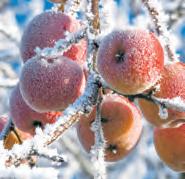
High winds, heavy rain and ice build up place a lot of stress on a tree, which can lead to fallen branches or structural damage. To protect your tree against storms, it is important to incorporate regular pruning into your tree’s maintenance. Pruning dead, dying and diseased branches can help reduce fallen branches during storms, while pruning to ensure structural integrity can better prepare your tree for the forces nature may inflict upon it over time. The best way to prepare your tree for any type of weather is by minimising preexisting stress. Planting the right tree in the right place coupled with regular care, creates conditions for your tree to thrive and therefore better resist and adapt to weather as it changes. This together with good plant hygiene, mulching and cutting out dead material will do much to give the tree and the fruit the best chance.
If you have any thoughts, ideas or views you would like to share with readers then write to us at Country Gardener emailing editorial@countrygardener or to Mount House, Halse, Taunton TA4 3AD
Perhaps it is just we are old gardening campaigners but I can’t let our visit to Cadhay Manor last week go without saying how much we loved it, how friendly everyone was and what a sheer delight it was to visit the gardens which if not at their spring best were not far from it. It is one of the most interesting Tudor mansions in Devon and the gardens are a delight. We rounded a perfect afternoon off with an ice cream at Sidmouth.
Alan Draper Exeter
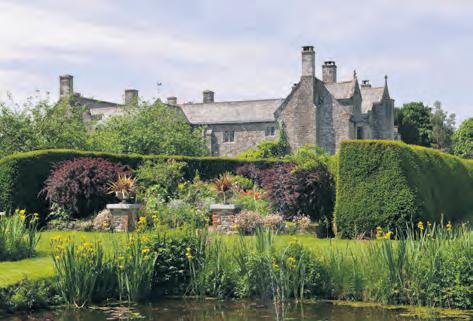
Don’t
I and my friends have been trying to persuade three local farmers that they do not need to cut the hedgerows every year. It seems to be a routine that no-one thinks about and I hope something can be done to educate, yes educate farmers!
The bigger a hedge, the more wildlife it supports. It is estimated that every year a hedgerow is left uncut it will gain two species of breeding bird; whilst some insects, such as the brown hairstreak butterfly, only lay their eggs on new growth. If this new growth is cut off each autumn or winter the eggs will die; one reason why the brown hairstreak is now so rare.
Research has shown that cutting hedges on a two- or three-year cycle usually saves on labour and machinery costs. Where hedges contain mainly slow-growing species such as hawthorn, savings may be as high as 60 per cent. Even where fast-growing species such as ash and willow predominate, savings are still likely.
JacquieChadwick via e-mail

DID YOU KNOW PICKING FOXGLOVES IS UNLUCKY?
I saw a reference to picking foxgloves in your magazine. I couldn’t resist letting you know that here in Devon and Cornwall, this is very unlucky because it robs the fairies, elves, and pixies of a plant they particularly delight in; in the north of England, foxglove flowers in the house are said to allow the Devil entrance. The plants have earned several, more sinister, names: dead man's bells and witch's gloves. The toxins can be absorbed via the skin or ingestion. So now you know!
Annie Folb Moretonhampstead

I read that Sally from Dorchester is angry that she couldn't take her "quiet and placid" dog into an NGS garden. I would like to give another point of view. Many people do not like dogs, some are afraid of them and garden owners surely cannot enjoy the effects of dog urine on their lawns. These owners, for whatever reason, have the absolute right to ban dogs from their gardens. They certainly cannot compromise, as Sally suggests, imagine the furore that would cause at the gate as dog owners plead their case! All NGS gardens state if dogs are allowed; if they are not, leave them at home.
Sue Albone CheltenhamI am enjoying the features on weather folklore in your excellent magazine. I love the tradition and history of it all. When we were children we were told of St Swithin’s Day which falls on July 15th each year.
According to tradition, whatever the weather is like on St Swithins Day –whether rainy or sunny – it will continue for the next 40 days and 40 nights. This story originated with St. Swithin, the Bishop of Winchester in the Anglo-Saxon era. He requested to be buried outside where he said he might be subject ‘to the feet of passers-by and to the raindrops pouring from on high.’
However, on 15th July, more than a century later, his body was moved to an indoor shrine. A heavy shower began – said to be a result of the Saint’s anger at being moved – and legend says that the rain continued from for 40 days and nights! I was about ten when we were told this story and we were terrified it was true when for the first five days after the 15th one year it rained and rained. It must be true we thought, only for the sixth day to see sunshine. I still remember it after all these years.
Jane Brooking Cheltenham
I want to say how much I appreciate what the retailer B&Q is doing to help gardeners recycle old pots. They seem to be leading the way. In and around this area of north Somerset finding someone to take plastic pots has been very difficult. B&Q has I understand install recycling stations to take the pots and they have won over a lot of people. Finally someone is doing it right.
Ringer Weston-super-Mare
I wanted to replace a lovely old rose which has been growing at the corner of my home for a good 20 years. I bought it cheaply and it turned out to be great value and flowered constantly. Then disease and decline set it and I needed to find something new. I went to my local garden centre and saw they stocked a leading national brand of roses. I was attracted as the name (which I will not mention) is respected and popular. But the price!. A climbing rose had a price tag of £42.50p. I love my roses but how can this be justified?
Tom Devereux Portishead

One of my gardening goals this summer is to keep going with wilder lawn areas. I am now 74 and getting the lawn cut is a huge task anyway but there’s another more justified reason. No Mow May went well last year and my lawn produced so many wonderful flowers and plants that I was amazed at what is waiting to appear given half a chance that I never could have imagined. I think this is a trend for the future.
Charleotte Dixon AvantAndrew Lancaster is a weather historian and lover of folklore. He is also a passionate gardener and looks at the magical qualities June brings with it.

There is one day of the summer which I love more than any other. It is always a day in mid-June, around the summer solstice and the 21st. The sun will be shining, and the day is so special because this is the day when the sun is literally straight above you and giving the most wonderful light.
It has a magical quality and a nostalgic one as it will be a long time before the light is exactly like this again. The June garden is new and yet full and rather like the sun itself is at the height of its powers. The roses know there will never be a better moment and they are everywhere, up walls, climbing over pergolas and leaning out from borders.
According to the Met Office the hours of daylight reach a peak in June. In Penzance, on the longest day, there will be around 16.14 hours of daylight. That is a lot of gardening hours should you need them.
June is rarely very warm. However, the hottest day of the year falls in June about 25 percent of the time (about the same as August). June is the only month that has not shown any warming trend during the last three centuries. Indeed, June seems to have become duller and wetter.
During June, we would expect to see an average of 73.4 mm of rainfall. Across the UK, June has more rainfall than May but less than July and August. In summer, most rain evaporates before it reaches plants. The amount of water that will soak up during a downpour depends on how dry the soil is. If it is already wet, the soil will be able to soak up more water. Plants use about 25 mm of water every week or so, therefore in June, the soil water reserves begin to reduce.
June temperatures allow you to sow vegetable seeds direct into the soil, where they will quickly germinate, and yield crops you will be able to enjoy this season. Salads such as radish, spring onion and lettuce are particularly successful sewn this way. Try planting colourful flowering perennials, biennials and hardy annuals too. Prepare weed-free beds that have been forked and raked.

You may be forgiven for thinking that June is too late for planting. The busiest season for getting seeds and young plants may have passed, but there is still plenty of the growing season left to enjoy! It is only in early May that gardens are generally considered ‘safe’ from frosts.
There’s still time to grow runner beans and french beans — sow them directly in the ground now. Sow beetroot thinly, directly into the ground. Sow broccoli and calabrese now in a nursery bed, for transplanting later on, or sow directly in your vegetable plot.
Midsummer’s Day is full of magic and with it comes a couple of pieces of weatherrelated folk lore. Until the change from the Julian to the Gregorian calendar in 1752 when Britain ‘lost’ 11 days, St Barnabas Day, now 11th June, fell on or close to midsummer as the traditional rhyme in the mid 17th century attests.
‘The longest day and the shortest night
When St Barnabas smiles both night and day
Poor ragged robin blooms in the hay’
Ragged robin is an old meadow plant and the reference is that weeds are still growing in the hay in June. Haymaking was a crucial day in the agricultural calendar and St Barnabas Day was traditionally the first day of haymaking and as the saying went ‘On the day of St Barnabas put the scythe to the grass’.
The strength of the sun on Midsummers Day was thought to imbue herbs with healing powers and this was the day they were traditionally gathered, at dawn.
Later in the month on the 25th St John’s Day became the traditional day to celebrate mid-summer.

The summer solstice falls at 21.50 on 20th June. This is the moment the sun is above the Tropic of Cancer the northernmost latitude at which it can be directly overhead. The word solstice comes from the latin solstutium meaning ‘sun standing still’ and is related to the position of sunset and sunrise on the horizon. Both points have been heading north day by day and will now appear to pause before setting off to the south again.

June has more than most when it comes to weather folklore sayings
1. June, damp and warm, does a farmer no harm.
2. A good rain in June sets all in tune.
3. A wet June makes a dry September.
4. If it rains on the feast of St. Medard (8th June), it will rain forty days later; but if it rains on St. Prottis (19th June), it will rain for the next forty days.
5. Rain on St. Barnabas’ Day (11th June) is good for grapes.
6. If St. Vitus’s Day (15th June) be rainy weather, it will rain for thirty days together.
7. If it rains on 27th June, it will rain for seven weeks.
Make the most of your greenhouse and prepare for sunny days by:
• Opening greenhouse vents and doors on warm days.
• Applying shade paint to the outside of the glass or using blinds on sunny days.
• Damping down the floor on sunny days, to increase humidity levels. This promotes plant growth and a reduced the risk of pests and mites.
• Allow greenhouse plants more space as they grow, to prevent disease and to avoid early pest infestations spreading.
• Check plants regularly, and seedlings daily and if they need watering, use rainwater or recycled water wherever possible.

Born naked and blind bird chicks are entirely helpless but their wide-open mouths are there for dropping insects, worms and caterpillars into and it isn’t long before the chicks grow feathers and start to seeresembling the birds they actually are. In June parent birds use every second of daylight to keep their little ones fed. Letting aphids, caterpillars and other tasty grubs remain on your garden plants means more food in the bellies of the chicks. After hatching in the spring, many chicks will now be leaving the safety of the nest. They’ll take a leap of faith, either flying high or fluttering to the ground. Remember to keep your eyes peeled for these balls of fluff in your garden and when visiting wildlife hotspots. They may look helpless, but leave them be! Parents will be keeping a beady eye on their chick’s progress until they gain full independence.


Gentle, steady winds make June a perfect time for kestrel fledglings to take to the air, learning the art of ‘windhovering’ over meadows of long grass, full of tasty voles. Kestrels generally prefer open habitats like grassland, farmland and heathland, but can also be spotted in towns and villages. You can identify them by spotting them hovering with their pointed wings held out. They have the ability to keep their heads still while hovering like this - even in strong winds - helping them to pinpoint their prey by sight.

June not only marks the appearance of baby birds, but bats, too! The summer nights may be shorter, but they’re alive with activity as bats swoop through the air hunting insects that swarm under moonlight. The warmer weather also means females will gather in large numbers to form maternity roosts before giving birth. Welcome bats into your garden or green space by having a variety of insect-tempting flowers.
There are many benefits of getting children involved in gardening and spending time in nature. While it is a useful way to stay active, spending time in nature also helps children develop healthy lifestyles. Caring for plants also children learn important life skills, such as patience, responsibility, and independence. Overall, spending time in nature can also help children develop their self-confidence and self-esteem. It is also a great way to learn more about a plant’s life cycle and the natural world.
CoirProducts.co.uk were the first to introduce a distinct range of coir bundles for kids back in 2020. Since then, we’ve expanded our coir portfolio for children bringing new and exciting sustainable horticultural growing products. With innovation and sustainability at the heart of what we do, our coir products range is also carbonneutral, which means, our coir bundles for kids are not only easy-to-use but are environmentally-friendly too. We are excited to launch our new project, Grow With Coir (www.growwithcoir.co.uk), solely dedicated to the next generation of gardeners and growers.
Our popular coir packs for children include the My Kid’s Playground Bundle, the My Little Gardener Bundle, and the My Secret Hobby Bundle. Each of these packs contains a variety of sizes of our signature products including CoirProducts CoirCoins, Coir Pots, Coir Discs and activity booklet. Crafted from the dust and fibres of the coconut husks, our coir products are natural, peat-free, and biodegradable. For children looking to grow some of their favourite products, we also have specially curated grow your own packs with seeds for growing broccoli, carrot, tomatoes, sunflowers, microgreens, and pumpkins.
CoirProducts coir pots that are included in these packs are an ideal alternative to plastic pots. A key advantage of them is that they allow plant roots to grow through the walls of the pot, which means, plants can simply be replanted or repotted as they grow bigger with the pot itself without plants having to go through any transplanting shock. CoirProducts CoirCoins are fully biodegradable, including coming with a biodegradable cover, and are perfect for sowing seeds, while CoirProducts coir discs give plenty of fluffy coir when hydrated. Coir has high water holding capacity as well as excellent air porosity, helping plants access the moisture they need. These natural properties of coir help plants develop stronger and healthier root systems.
As a purpose-driven company, we also continue to support school gardening initiatives, so that more and more children can get involved in growing their favourite plants and crops.
Significantly, with the holding company attaining carbon neutrality, we guarantee a product that is not only of high quality, but also produced, sourced, and transported in an environmentally sustainable manner. The company has verified its greenhouse gas emissions as per ISO standards, while offsetting its remaining carbon footprint in transporting goods to the UK as per UNFCCC process.

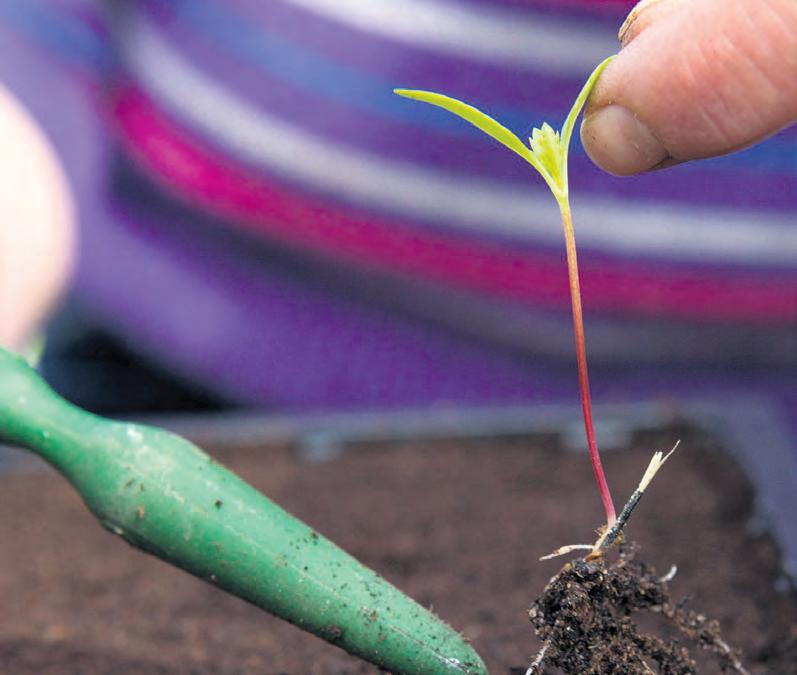
Joe Stevenson has been growing things in his Exeter garden and nearby allotment for over 40 years. He has learnt a lot about seeds and starting off plants from seeds and believes people need a little help.
I don’t think there’s any great secret to being able to garden well. I think patience is an underrated skill in the process and not hurrying things.
It is mostly I have found, common sense and in some cases trial and error and not being too ambitious.
I’ve been gardening for as long as I can remember. And I try and help people on the allotment when I can.
Here’s some of the things I would like to be able to pass on. Some of this may seem basic but I think it will help.
When you buy a packet of seeds read the instructions carefully. Someone has gone to a lot of trouble to set out the ideal circumstances for sowing that particular seed. Stick to the sowing month it tells you to. Sometimes you can get away with it if you sow early or late but mostly you don’t.
Sow most seeds in compost into four-inch pots which will give them a good depth for their roots. If the seeds are large cover with compost top the same depth of the seed. Water straight away and you must use a rose with a fine spray or you’ll wash the seed away.
Keep the pots out of the direct sunlight. Don’t go thinking the sun will be good for them. It won’t be. It will dry everything out. When people tell me only half their seeds have germinated the chances are they planted out the freshly sown seeds into the heat. Prick the seedlings into individual pots when they are easy to handle. This will vary of course from seedling to seedling but when the first leaves have appeared then hey can be moved on to the next stage.
“When you handle seedlings always pick them up by the leaves and never the stem or roots. Treat them as gently as you possibly can.”
Water your seedlings with an organic fungicide to stop them being attacked by fungus. This is important especially in an allotment where there is a lot going on in. a small area and lots of airborne diseases are a threat.
Potted up seedlings should be given a weekly feed of Phostrogen. Always make sure any young plant is properly watered before you move it into position. A little bonemeal scattered into a planting hole will help.
Have a strong word with your cat to ensure he or she knows the difference between a seedling tray and a litter tray.
That’s it really. Seeds and seedlings are such an important part of the gardeners’ trade that I always feel it helps to concentrate on getting these things right in the early stages. Seedlings are delicate, wonderful things and they need to be understood and loved.
Your pond isn’t just a relaxing place to hang out. It’s a living, breathing ecosystem full of fish, plants, bacteria and other life that you can’t even see.
Lots of imbalances in your pond’s biology can cause different kinds of water clarity issues. If you want crystal-clear water, your first step is to determine what kind of problem you have. You’ve put a lot of time and money into building your pond. Now, you just want to put up your feet and watch the koi flit around their crystal-clear water.
But what if the water isn’t clear? What do you do if your fish are hidden behind a haze of green-water algae, or your rocks are covered in green slimy gunk?
Disruptions to your pond’s ecosystem can tint your beautiful water an unsightly green or brown. The good news is you can keep your water clear relatively easily – without using harsh chemicals.
Single-cell algae are tiny organisms that live in your pond and turn the water pea soup green. You’ll know you have a single-cell algae problem if your hand looks green or disappears entirely when you submerge it in the water.
Algae is not inherently bad; it’s just nature’s way of dealing with excess nutrients. Singlecell algae arrive in your pond as tiny airborne spores. These spores feed on nitrites, a natural byproduct of beneficial bacteria breaking down harmful ammonia in the water. String algae is the most common type of algae in fish ponds and waterfalls. It’s slimy and green, and you might even be able to pick it up with your hands. Unlike single-cell algae, string algae will not turn your water green. Instead, it clings to rocks, liner and plants, or floats on the surface of the water.
String algae is a natural, normal, expected and even beneficial part of your pond’s ecosystem. You will always have a little bit of it hanging around,
Gardeners can eliminate green water by introducing more beneficial bacteria into the pond. Some easy steps to take
• Understand that a little bit of algae or discoloration is normal
• Use beneficial bacteria to starve single-cell algae that turns water green
• Add a wide variety of aquatic plants to starve string algae
• Add a larger biofilter
• Don’t overfeed your fish
• Don’t overcrowd your fish
• Don’t power wash your rocks
• Keep your water oxygenated
• Watch for any debris that may be washing into your pond
Green water comes from an accumulation of single celled algae. These tiny cells are too small to be trapped by filter sponges. Trees, bushes, and other plants will drop leaves and debris. Fish and wildlife that may visit your pond will create waste. All this matter comes together to create sludge and murky water.
The best way to combat this is to install a pond filter. OASE has a filter to suit any pond. From small in-pond filters to pressure filters, to box filters to large drum filters that can filter koi ponds up to 100,000 litres.
Visit your local OASE retailer for help on which filter, pump and UV will suit your specific pond system.
Contact enquiries@oase.com Tel: 01256 896886 www.oase.com
The WaterMate® revolutionises gardening with its smart, solar-powered watering system. Spend less time watering and conserve water effortlessly. You can choose from two convenient kits - Mini for greenhouses under six square metres, or Pro for greenhouses and polytunnels up to 40 square metres. With dual-zone watering, precise control, and smart sensors, it ensures healthy plants no matter what you grow. Easy to install and manage remotely via app, it adapts to your garden’s needs, responding to weather conditions. Upgrade your gardening experience so you can spend more time enjoying your garden! www.harvst.co.uk

OASE‘s top tips for pond filtration
Good filtration is the key to any healthy looking pond. With OASE anyone can achieve crystal clear pond water this summer. One of the easiest ways to achieve this is with OASE FiltoClear pressurised filters.
Not only is a FiltoClear easy to install but it’s even simpler to clean. Just turn the nozzle to “Clean” and pump the handle at the top of the head unit until the water runs clear, that’s it! On top of this, the unit also includes a UV clarifier that gets rid of floating algae and bacteria.
The FiltoClear is available by itself or as a set with the OASE AquaMax Eco Premium pump, making it even easier to get clear pond water. It is the complete pond filter package for your garden.
The FiltoClear range is developed to be out of sight and out of mind. OASE also offer a clear water guarantee when an OASE pump, filter and UV are all used together.
Find the OASE FiltoClear from your local retailer today and enjoy clear pond water this summer.

01256 896886 enquiries@oase.com www.oase.com
• Greenhouses • Polytunnels • Garden Beds
Pots
Allotments
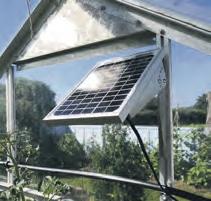
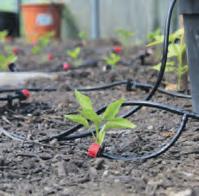



It beggars belief but with the longest day of the year only a few weeks away the garden is growing at a rapid pace. The frenzy of spring should be slowing into a more regular rhythm. It’s also a time to prune, mow and weed, as natural growth starts to run riot. The hundreds of young plants you have been raising should have left the confines of the greenhouse and are now making their own way in the world. Consequently, all you must do in terms of your gardening jobs is keep up with the watering, weeding, grass cutting, hedge trimming, etc, etc. Keep tubs and planting containers wellhydrated too, even in rainy weather, as much of the water runs from the leaves over the side. 1 3
Shrubs such as weigela, kolkwitzia and deutzia will probably have finished flowering by now, so they can be pruned. It is best to cut off about one third of the stems as this will let more air and light into the shrub. After pruning it is a good idea to feed with a multi-purpose feed.
A lot of fruit trees such as apples, pears and plums will start to fall off the plant in June. This is called ‘June drop’. This is because fruit trees produce a lot of young fruits but the tree cannot produce enough nutrients to enable them to all grow into healthy fruit. Therefore, some of them will drop off. However, you may need to thin out the fruit crops further to produce a better final overall crop. Below is a guideline of the spacing you should try to give the fruit to develop fully.
Dianthus are very popular plants due to their spicy clove scent. June is a good time to take cuttings of these plants. Take the cuttings from young nonflowering shoots cutting about five leaf pairs from the tip. Pull off the bottom pair of leaves and place the cuttings round the edge of an 8cm pot filled. Water in gently and keep in a shady place. Do not cover as the cuttings may go mouldy.


• Cooking apple: fruit 15 to 22cm apart • Dessert apple: fruit 10-15 cm apart • Pears: fruit 10-15cm apart • Plums: fruit 8-10cm apart
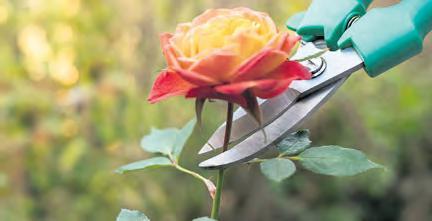
6
are at their peak.
Snap off just below the head - this is thought to make new blooms appear more quickly than the classic method of cutting just above a leaf.
Early varieties of potatoes will be ready to dig up in late June. Wait until the leaves start to turn yellow and then feel under the ground to check how large the tubers are, then lift your early potatoes as and when you need them. Don’t be in too much of a rush, as you’ll get bigger tubers the longer you wait. Second-early potato varieties will follow in July and maincrop varieties can stay in the ground until September to have time to get big.

7
Time to pant biennials
Biennials, such as honesty, wallflowers and sweet rocket, are sown in spring to flower the following year. You can either move young plants to a nursery bed in a quiet spot outdoors for moving again in the autumn or put them in their flowering positions. You’ll find plants at the local garden centre or via online retailers.
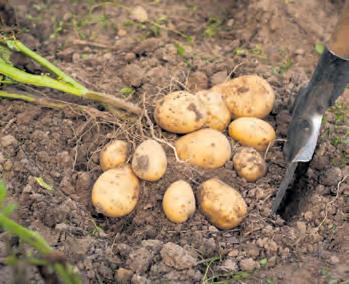
4


5
Plant outdoor tomatoes
It is safe to plant tomatoes outdoors now. They can either go straight into the ground or into a growbag. Tomatoes need a sunny sheltered spot and will do best against a south-facing wall. Ensure to water them well and also feed them to have the best tomato crop.

Now the garden is full of growth and the lawn is being cut regularly, there will be plenty of material available for composting. Make sure that you fill your compost bin with an equal volume of nitrogen-rich material (grass clippings, manure, shrub prunings) and carbon-rich material (flower stalks, shredded paper, woody clippings). Keep your compost bin moist. The contents should hold together, but not drip water, when you squeeze a handful.
If you want compost fast, the secret for success is to turn the contents of your bin once a week. When this was trialled well-rotted compost was made in ten weeks. When you add grass clippings to the heap, add a shovelful of soil, too as this will speed up the composting process.
9
Cordon tomatoes are best grown as singlestemmed plants. However, these vigorous plants naturally produce side-shoots from the joints where leaves sprout from the main stem. These side-shoots should be pinched out to keep plants growing vertically on just one stem.
Large side shoots can be used as cuttings to start other plants. You can stand them in a glass of water for a week or two or use rooting gel.
Sometimes tomato growers allow a large side shoot to grow into a second main stem. This has the advantage of growing more trusses at a lower height from one plant.

Bush varieties, also known as determinate, do not need their side shoots removed. However, there are situations when it may be wise to remove some of them if growing large tomatoes and you would like the fruit to mature earlier rather than later.
Of course, by removing side shoots on bush varieties, you will reduce the number of flowers and fruit that would grow over a long season.
By the end of May
most areas will have seen the last chance of frost, so early June is the perfect time to start planting out tender annuals like nicotiana, cosmos or salvia. Prepare the beds in advance and use nematodes watered on the soil to give them a bit of protection from slugs while they get established.
12 14
Now is the ideal time to take cuttings from any hydrangea shrub. Take a cutting from a branch of the hydrangea shrub about five inches long. The belief is the cutting will work best if taken from a branch that did not flower this year. Remove the lower leaves of the bottom two leaf nodes. The leaf node is where a leaf comes out of the branch.
Remove the lower leaves from the stem and if the top leaves are large, cut them in half to help reduce water loss and wilting. 11
Sow seeds of annual flowers to fill gaps. Mix the seeds into sand or cover seeds with a mix of potting compost and sand so you can easily spot which areas you have sown and don’t enthusiastically hoe or pull up seedlings by mistake. Remember to keep the soil moist until they have germinated and the seedlings have grown into their space.
Keep sowing salad leaves and lettuces. If you find them too fiddly try using seed tape – seeds set into paper tape-a clever way of ensuring you don’t sow too thickly. Plus, it ensures straight rows. They are a bit more expensive but satisfying.
Sow spinach and kale. Both are useful crops that are easy to grow and good to eat. Sow F1 varieties for reliable performance. Use the thinnings for salads. June is the last time realistically to sow green beans.
There’s still time - just, to get another crop in the ground to enjoy
Liquid tomato feed can be used as a supplement on ornamental as well as productive plants. Anything potted into compost and containerised, such as summer bedding, will benefit from a fortnightly feed of tomato feed because the nutrients in the compost run out after three to four weeks. If you find the watering can too heavy, invest in a smaller one.
Feed all greenhouse crops such as cucumbers and tomatoes and continue to apply a fortnightly feed until the beginning of September. Agapanthus, often said to thrive on a poor diet, respond well to being fed with tomato food. You’ll get far more flowers.
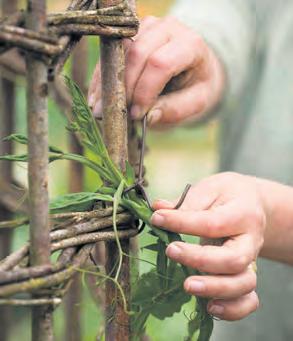
13 15
Your annual sweet peas should be nicely settled into their new homes for the summer and they will start to grow rapidly now. Tie in any shoots to your supports. For the best quality flowers, remove all the side shoots to create a cordon, as you would with a tomato plant.
Watch out for aphids as they love the fleshy growing tips. They’re full of sap and as a result they will quickly colonise them. If you have any early flowers, they might drop some buds. Don’t worry, this is a symptom of cold nights and is the plant’s way of regulating water pressure. They will soon recover as the nights warm up.

Look out for slugs and snails hiding in nooks and crannies. One thing is certain -they’ll be out in force after all those tender young shoots coming up this month. Hunts are best done in early morning and evening when cool damp air brings them into the open. Depending on how much of a problem they are in the garden you can try various control methods. Nematodes (microscopic organisms that predate on slugs and snails) are organic and safe with pets and children but require careful application.
Also try non-toxic and eco-friendly slug granules. These make crossing them unpleasant for slugs and snails and offer good protection. They’re made from sepiolite clay, a natural material that is dry and sharp which can be used with edibles. There are also organic pellets available to buy. If, however, you have a really serious problem you may need to resort to old school slug pellets.
Protect the growing tips of beans from slug damage. They don’t recover, push some new beans into the ground as replacements if needed.
Try to site pots up and out of reach of slugs who will eat the heads of violas in double quick time.
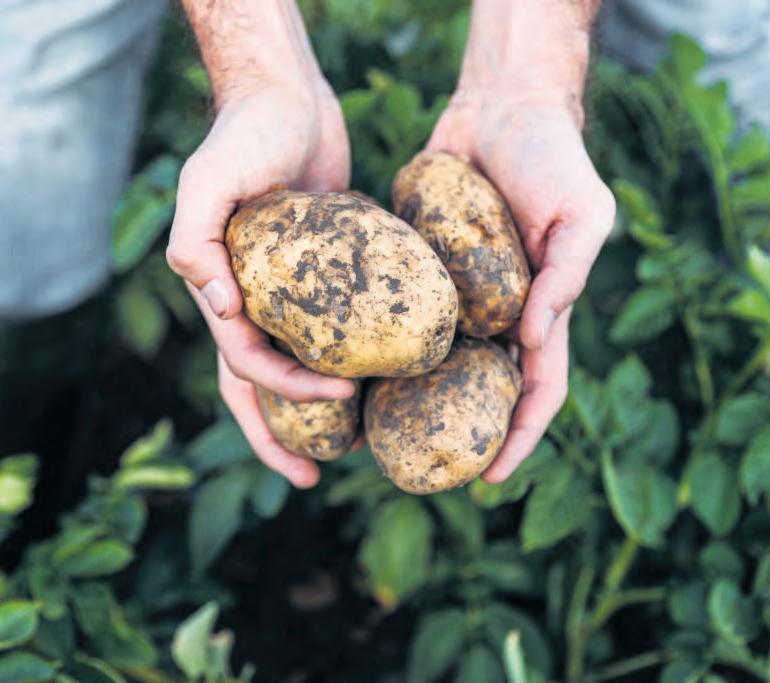
Potatoes are the most generous of all crops and will pay you back many times over. In fact, there is still time to plant them with the seed potatoes able to catch up during the summer and provide a wonderful late harvest.
If those harvests do come later, they will still be as productive and more importantly enjoyable.
When you plant later there’s no need to chit seed potatoes (chitting is leaving them in the light indoors to sprout) because the later soil will still be warm.
Leftover maincrop seed potatoes will still grow well. You can use supermarket sprouting potatoes, but you run the risk of the crops being more variable. The technique known as earthing up is the best way to increase your harvest. All this means is that every time the green growth reaches about 20cms tall use a spade or hoe to pull up some of the surrounding soil to cover the stems and protect the growing tubers.
As well as helping the tubers to form it is a process which ensures any near the surface do not turn green and become inedible. This will happen if the sunlight gets to the potatoes and exposes them to the light.
In dry periods potatoes will need regular watering especially if you are growing them in a pot or container. This encourages the new potatoes to swell. This helps retain moisture mulch between the rows, grass cuttings are useful for this if you haven’t used a weedkiller on the lawn.
How late can you leave planting?
Certainly, early June will give the potatoes chance to form grow and swell and you will more than likely have a wonderful early to late autumn crop -much later than you thought possible.
Traditional trench
The well rehearsed way of planting potatoes at the bottom of a trench which is 10cms to 15cms deep covering them back over then adding an extra mount of soil. Trench depth can vary and should be shallower for salad varieties such as ”Pink Fir Apple’.
In containers
A rewarding way of growing potatoes. Plant each potato into a 30cms x 30cms container with drainage holes. Fill the base with 10cms of garden soil, lay the seed potatoes on top and cover with 10cms soil. As the plants grow cover them by adding more soil or compost. Repeat until you get to the top of the pot.
Under a mulch sheet
Cover the soil with a sheet of biodegradable mulch, cutting crosses in the fabric to plant the seed potatoes. There’s no need to earth them up, just leave the tubers in the dark and remove the sheet when you are ready to harvest.


The temptation of organising a gardening day out is never greater than when May moves into June. Roses are soon to be at their best and borders are suddenly colourful and dramatic.
So, if you are looking for a gardening day out or a longer gardening themed break over the next few weeks then the south west is a dream come true.
It offers so many opportunities at a time of the year when garden lovers look forward to getting out and about and indulging their passion.
Private gardens will be at their best as head gardeners and owners get everything ready for summer visitors. The list of things to do probably reaches its peak over the next few weeks with gardens big and small open, village fetes and fairs, plant shows, county shows and plant sales. We have rounded up some idea of places to visit, things to do, events to take part in so you can make the most of what promises to be a sensational early summer.
The Bishop’s Palace in the heart of Wells are preparing for a n exciting summer. The 14 acres of tranquil gardens in the heart of medieval Wells will be hosting a series summer events for the family including a Tournament of Knights, Hansel and Gretel Opera and two nights of Shakespeare. The focus of course remains the stunning gardens in the heart of Wells.
You can wander along and around the many herbaceous borders, savour the scent of roses in the parterre, admire the beautiful views of the gardens, moat and further afield from the top of the ramparts.
Over the years the gardens have changed as successive bishops have added their legacy and today these gardens have Grade II listed garden status due to their historic nature. In 2016, the gardens were acknowledged by the Royal Horticultural Society, by being made a “Partner Garden”.
Entry is free most Fridays to RHS members with starred cards. This offer is not valid on certain event days so check the website for details where you can find details of all the summer events being held
Bishop’s Palace and Gardens, Wells BA5 2PD www.bishopspalace.org.uk
Forde Abbey is looking forward to a summer of sweet peas as its famous display have been planted and the wigwams are in place.The peak time is anticipated in July and the two weeks set aside are from July 1st to July 15th .The Abbey is looking forward to a spectacular summer filled with fragrance and an explosion of colour. There will be bunches available at the Gift Shop. Times: 10:30 am to 5pm (Last entry at 4 pm) Tickets: Adults £14.50. Children (5 to 15 years) £5. The abbey gardens remain a huge summer attraction.

Here’s a date to save in your diary: Sunday, 16th June marks the first Badminton House Open Garden Day. You should be prepared to be captivated by the splendour of Badminton House gardens, adorned with vibrant roses. Designed by Russell Page and Francois Goffinet, these gardens promise a visual treat. Explore the historic grounds, pick up horticultural tips, enjoy food and refreshments, including cream teas, and browse plant and flower stalls. Also opening will be ‘A Garden of Botanical Art,’ featuring reproductions of paintings from Mary Somerset’s collection. Tickets are £5. Secure your spot at www.badmintonestate.com for a delightful day filled with nature and art.
Badminton Estate South Gloucestershire, Badminton GL9 1DD
Home to the highest-powered fountain in the country, the award-winning gardens include topiary-lined vistas, colourful herbaceous borders, an arboretum, and a bog garden, which provides all year-round interest.
Forde Abbey Estate, Chard, Somerset TA20 4LU

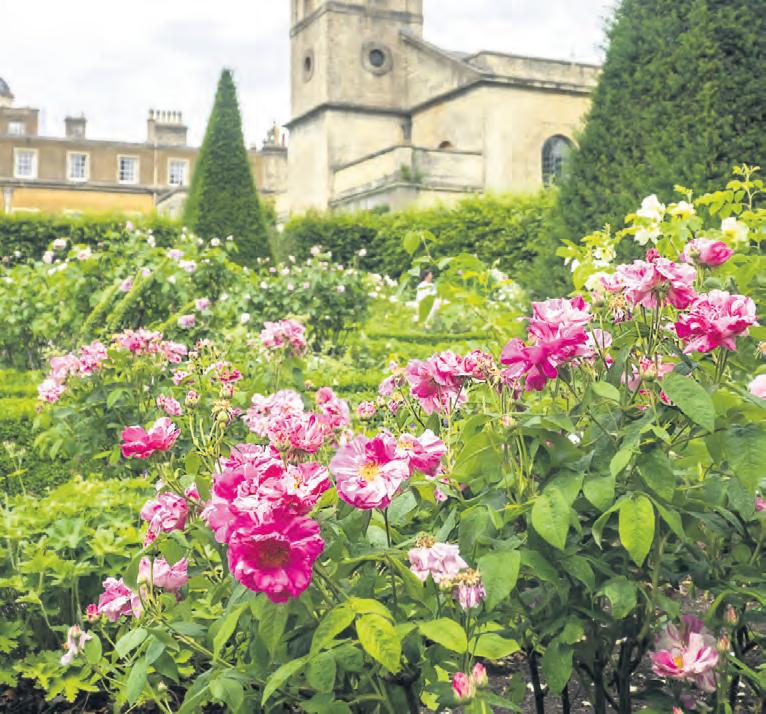
The new gardeners at Cadhay have been busy planting and visitors should begin to see subtle changes as the new team makes its mark. The medieval ponds, which form the backbone of the gardens, will look resplendent throughout June. The allotment holders have been busier than ever and it is always interesting to see their plots taking shape in June. The sundial, awarded to Cadhay by the NGS after 50 years, will be on display. Cadhay is open on Friday afternoons throughout the Summer from 2pm.
Contact jayne@cadhay.org.uk or 01404813511 Cadhay, Ottery Saint Mary EX11 1QT
From stately acres to country cottage gardens the National Garden Scheme opens exceptional private gardens to the public across England, Wales, Northern Island and the Channel Islands. In June, thousands of beautiful spaces open, many serving delicious home-made refreshments and plants for sale, all offering wonderful value for money while helping to raise millions for nursing and health charities each year.
Visit a National Garden Scheme Garden in June and be inspired www.ngs.org.uk


About 25 Private Gardens Open 15th & 16th June, 2-6pm Day ticket to all gardens £8 Ticket for 2 days £10 Accompanied children free Open Gardens Teas served from 1pm Well stocked plant stall from 1pm Free Car Park (DT2 7GD) from 1pm Equal proceeds to: Cerne Historical Society (Abbey dig) & Godmanstone Church Restoration Keep up to date: www.cerneabbasopengardens.org.uk

Enjoy the historic Abbey with its beautiful gardens & walks to the beach, where wild flowers & cultivation meet seamlessly

Visit this family home with its stunning architecture & collections. Enjoy ‘William Stukeley - Saviour of Stonehenge’ exhibition. See where ‘Malory Towers’ is filmed!
* Dogs welcome * Holiday Cottages * * Delicious light lunches & cream teas *
* Hartland Quay 1 mile *
House, Gardens, Exhibitions etc and Café open until 3rd October
4pm)
rooms only closed 17th June - 11th July for filming For more information and special events see www.hartlandabbey.com Hartland, Nr. Bideford EX39 6DT 01237441496/234



“There is no better month than June to visit the iconic cottage garden at East Lambrook Manor,” says Mike Werkmeister, who with his late wife Gail have cared for the garden for the last sixteen years. “The garden is a joy to see in June, it’s when the garden reaches its summer peak and is simply sublime.”
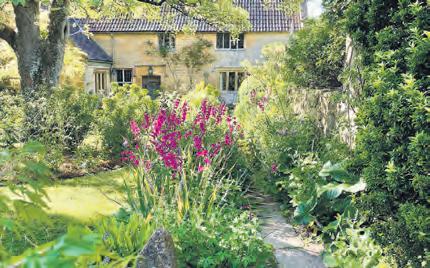
The garden at East Lambrook was created between 1939 and 1969 by Margery Fish, legendary plantswoman and grande dame of English cottage gardening, and made famous through her many books, the first of which ‘We Made a Garden’ written in 1956 and a veritable hardy perennial of gardening books, has just been republished for the umpteenth time. Old-fashioned roses fill the air with scent and perennials, such as Margery Fish favourites hardy geraniums and Astrantia, are to the fore in the garden while Gladiolus byzantinus dot the beds with vibrant splashes of cerise. Many cottage garden treasures can be bought in the garden’s Margery Fish Plant Nursery.
The Malthouse Gallery, situated in the garden, is host to the annual summer exhibition of local watercolour artist Moish Sokal, celebrating 30 years of exhibiting in the gallery, and delicious cakes can be enjoyed in the Malthouse Café. Garden, nursery, café and gallery open Tuesday to Saturday, 10am - 5pm.
East Lambrook Manor Gardens, Silver Street, East Lambrook, South Petherton TA13 5HH Tel: 01460 240328 www.eastlambrook.com
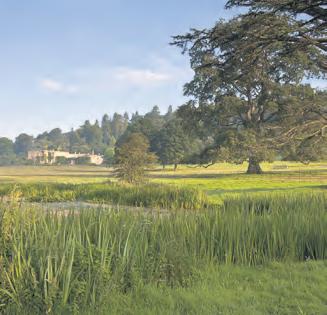
With far-reaching views, formal terraces, rolling lawns, ancient trees and even an extinct volcano, the different areas of the garden at Killerton are perfect for walks. Whether you’re visiting for a gentle stroll or to relax with the family, there’s room to explore at your own pace.
Stretching out behind the mansion house is the Terrace Garden. The herbaceous flowering bed is a canvas of colour in the summer and the four larger beds contain hazel and willow obelisks which support four different types of annual climbers. Neatly cut, sloping lawns and a variety of historic rhododendrons frame the more formal areas. Follow the path passing the large ornamental urns towards the larger lawn dotted with mature trees. Killerton is open every day (except Christmas Day and Boxing Day) National Trust members visit for free. See website for opening times and admission. www.nationaltrust.org.uk/visit/devon/killerton


GARDENS & TEAROOM
Open every Friday 2pm - 5.30pm from 3rd May to 27th September

Also last weekend in May & August Bank Holiday weekend - Sat, Sun & Mon GARDENS: adult £5, child £1
1QT 01404 813511 www.cadhay.org.uk Member of Historic Houses









Historic Cerne Abbas is most famous for its Giant but after that it is known for the annual Open Gardens weekend where some 25 private gardens are open to raise money for village and Dorset good causes. Last year’s event featured in the Channel 5 series ‘Dorset Country & Coast’.
The gardens are open from 2pm to 6 pm on Saturday 15th and Sunday 16th June. Entrance to all gardens is by a single day ticket which costs £8 for adults while accompanying younger folk under 16 are free. A few gardens are accessible for wheelchairs and most gardens accept well behaved dogs on leads. The free car park, well-regarded plant stall and teas provided by the local youth club, all commencing at 1pm. Almost all gardens are within easy walking distance of the free car park and are located on maps distributed with the ticket.
Cerne’s Open Gardens began in 1974 so this year they will mark the 50th anniversary and 48th event. Once again Cerne Abbas looks forward to welcoming regular and new visitors to the village, More information on www.cerneabbas opengardens.org.uk


Barthelemy and Co perhaps the best place in Britain for Japanese maples

Barthelemy and Co near Wimborne Dorset is a Japanese maple nursery that was founded in 1920. From sourcing and picking the seeds, over 100,000 Japanese Maples are produced and grown each year on the nursery by the Skinner family.
Approximately 10-12,000 of these seedlings go on to be grafted with named varieties, using techniques passed down through the generations. Their focus on Japanese Maples has allowed them to perfect their growing and grafting techniques, producing some of the finest specimens available in the UK. Barthélemy & Co is not just a place to buy plants, but a living museum of horticultural history, where every aspect of the growing process is done with care and attention to detail. Visitors to the nursery can see the passion and dedication involved on display, and leave with a new appreciation for the beauty and complexity of these unique and captivating trees.
Barthelemy and Co, 262 Wimborne Rd W, Wimborne BH21 2DZ
Here comes the chance to immerse yourself in the fragrance and spectacle of thousands of roses in bud and in bloom in two dedicated gardens at the Festival of Roses, from 15 June to 14 July at RHS Garden Rosemoor.
There’s no better place to admire the breadth of colour, shape and habitat of these national favourites in early summer. Boasting one of the UK’s largest collections of roses, Rosemoor is home to more than 200 different varieties and over 2,000 specimens, ranging from traditional cottage garden climbers to modern varieties, all planted in different settings and combinations in the heart of the garden. It’s a sensory experience that is not to be missed!
Join one of the weekly walks or talk to their advisory team to make the most of your visit. Alternatively, visit for the Rose Weekend on 21 to 23 June where you can also enjoy family entertainment and a rose themed artisan craft and food market.
RHS Garden Rosemoor, Torrington EX38 8PH
June - a glorious time to visit Hartland Abbey
June is a wonderful month when the wildflowers on the walks to the beach, on the cliffs and in the woodland gardens at Hartland Abbey are at their best. Wildflowers lead visitors through rhododendrons and azaleas to the Walled Gardens, bursting with exuberantly planted beds, within south facing, gently curving 18th Century walls. The bog garden and fernery designed by Jekyll provide interest en route…. the tree ferns have bred young in abundance! Followers of Enid Blyton’s ‘Malory Towers’, filmed at Hartland Abbey, enjoy spotting locations around the gardens. The Abbey, passed down through the generations since the Dissolution, is full of national and local interest with seals in the museum going back to the 12thC. Also of current interest is the ‘William Stukeley – Saviour of Stonehenge’ exhibition since the recent Channel 5 programme ‘Stonehenge: The Discovery with Dan Snow’. The main reception rooms only will be closed for filming from 17th June to 11th July; all exhibitions, tea room, gift shop etc will be open from 11am. www.hartlandabbey.com Tel: 01237441496/234
Kelmscott Manor - enchanting riverside gardens
Kelmscott Manor was the iconic country home of William Morris; father of the Arts and Crafts movement.
Today, visitors will find an outstanding collection which spans over 300 years and reflects the lives, ideas, and creative legacy of those who lived and stayed there.
The domestic charm and ambience of the house is still retained and having influenced Pre-Raphaelite art and design and the Arts & Crafts Movement, its legacy still very much treasured today.
Kelmscott Manor also boasts enchanting riverside gardens and the River Thames is located just a few hundred yards away. For more information visit kelmscottmanor.org.uk Kelmscott Manor Kelmscott, Lechlade GL7 3HJ
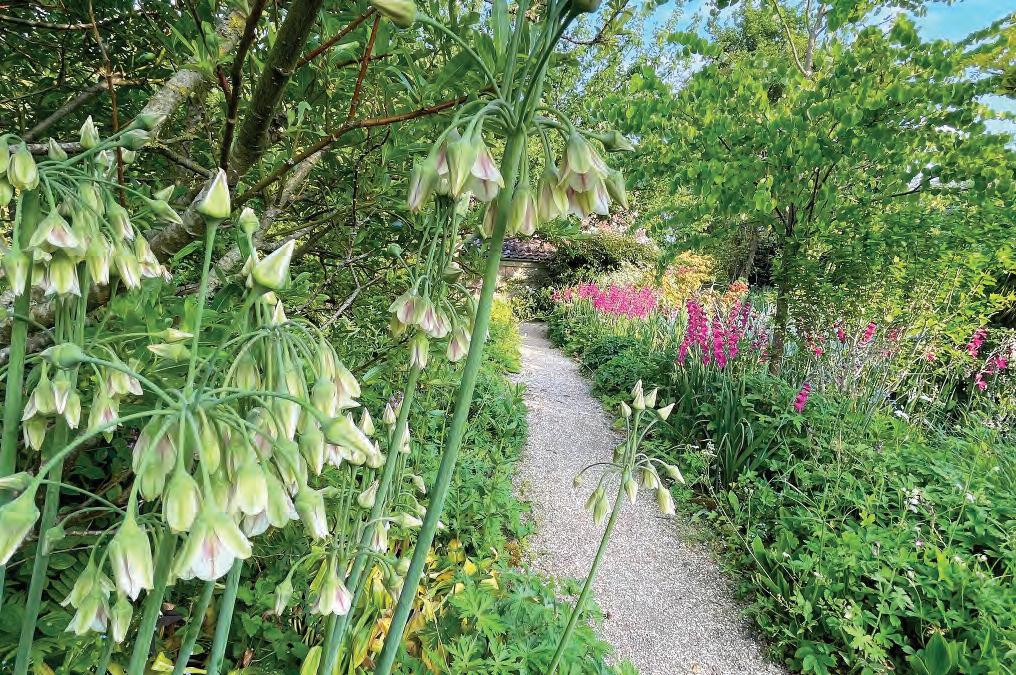

Iconic cottage garden, nursery, café and gallery
A visit to the iconic garden of gardening legend Margery Fish is always a joy, never more so than in June when it is sublime.

We produce and grow the largest selection available in the UK. Plants are pot grown and suitable for garden, patio or bonsai.
Visitors welcome Mon-Sat 9am-1pm & 2pm-4pm
Barthelemy & Co (DCG), 262 Wimborne Rd West, Stapehill, Wimborne, Dorset BH21 2DZ Tel: 01202 874283 enquiries@barthelemymaples.co.uk www.barthelemymaples.co.uk



sunshine, flowers and cake!
Gather friends and family to celebrate summer with a cup of goodwill and host a Great British Garden Party fundraiser for nursing and health charities.


Tea Room & Walled Garden Nursery BEHAVED DOGS

Nestled in the heart of North Devon, Marwood Hill Garden is a hidden gem
Home to four National Plant Heritage collections, this private valley garden spans over 20-acres and showcases three stunning lakes, rare trees & shrubs, and colourful surprises throughout each season. Not only a haven for wildlife, the garden is also the perfect environment to explore and be inspired. Enjoy a day of inspirational and relaxation for the whole family.
Catch up over coffee and homemade cake or a cream tea in the picturesque Garden Tea Room or take a bit of Marwood magic home with you from our Walled Garden Nursery and Plant Sales.
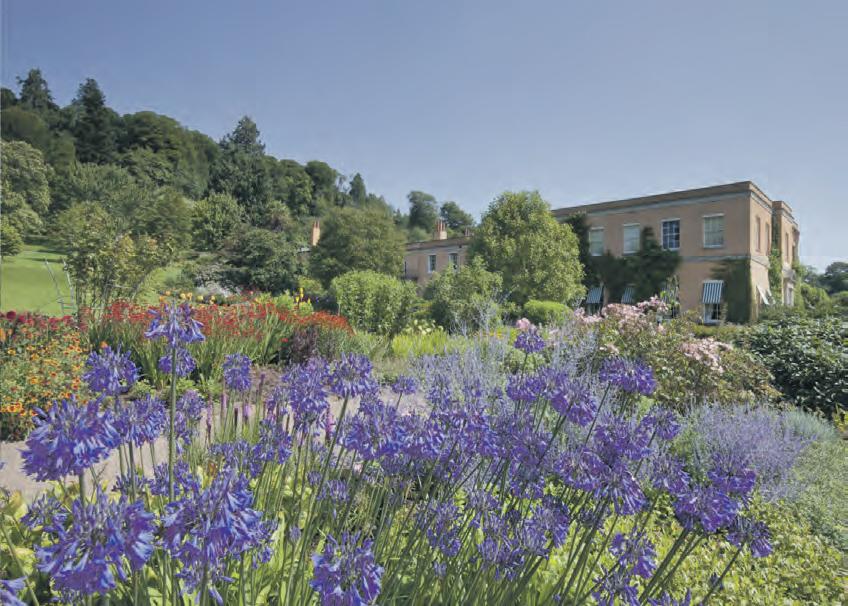

Enquiries & Tea Room 01271 342528

Plant Sales & Nursery 01271 342577 e info@marwoodhillgarden.co.uk w marwoodhillgarden.co.uk
Marwood Hill Gardens, Marwood, Barnstaple, Devon EX31 4EA




Warmer days on the way to celebrate
Marwood Hill Gardens
Long warm sunny days entice the herbaceous plants to flower, with multicoloured Candelabra Primulas snaking along the stream and around the lakes. By the end of the month these colourful flowers are joined by gorgeous drifts of Japanese Iris and Astilbes. The herbaceous borders are aglow with colour and the Mediterranean border in front of the tea-room provides a visual feast to view while enjoying a delicious homemade cream tea from the Tea Room.

Alpines planted along the scree-bed continue to provide an amazing contrast of foliage and flower while above creamy Cornus Kousa flowers burst into bloom.
Do visit the plant sales for the unusual, as well as the tried and tested. They propagate nearly all the plants that they sell from cuttings or divisions from the gardens, and all in peat free compost!
Marwood Hill Gardens, Nr Guineaford, Barnstaple, North Devon EX31 4EA www.marwoodhillgarden.co.uk Tel: 01271 342 528 Email: info@marwoodhillgarden.co.uk
Boscrege Caravan and Touring park in Cornwall is a peaceful and picturesque park, set at the foot of Tregonning Hill, Godolphin National Trust and amongst tranquil Cornish lanes in an area of outstanding natural beauty. The park, open all year is close to the Cornwall coast and a few minutes’ drive to Praa Sands, one of Britain’s nicest beaches. So, if you are looking to take a luxury holiday (doggie friendly with dog friendly homes and on-site designated fields for the dogs too) in Cornwall in either a self-catering caravan, lodge, touring or even purchasing your own holiday home then contact Boscrege Caravan and Touring Park.
Boscrege Caravan Park, Boscrege, Ashton, Cornwall TR13 9TG Tel: 01736 762231 www.caravanparkcornwall.com

Bishop's Palace & Gardens, Wells, Somerset
14 acres of tranquil RHS partner gardens, moat, medieval Palace building and award winning Bishop's Table café in the heart of medieval Wells.
Tickets to the Palace and gardens are valid for 12 months from purchase on any normal sightseeing day.
Purchase on site or online at: www.bishopspalace.org.uk

Over 300 stallholders will form the heart of the Garden Show at Stansted Park from Friday 7th June to Sunday 9th June under the theme of ‘ Art Design , Your Garden and You’.
It is the 30th anniversary of the popular show -one of a series of three organised under the Garden Shows banner. There will be plenty of quality shows to purchase, garden goods and gifts and crafts. Garden advice with talks are free and family fun is an added dimension.
Tickets £14 on the gate, seniors £12 and children £5. Friday arrival 10am to 12 noon are prep booked tickets and there’s a 15 per-cent discount with tickets booked online.The Broadlands show in the series takes place form July 26th to July 28th.
www.thegardenshows.com





Think of June, and of course, roses - and we’ve a great selection of gardens opening their gates for charity, where you’ll find not only glorious roses but all the colourful growth of early summer. So if you want to travel further from home or can find one in your locality, here are open gardens across the counties Country Gardener covers. Do try to check before starting out as circumstances can force cancellations.


Gold Hill, Batcombe, Shepton Mallet, Somerset BA4 6HF
Opening for the National Garden Scheme on Saturday 15th June, 12pm-5.30pm, a plantswoman’s and designer’s garden of two parts – one a riot of colour through kitchen terraces, potager leading to wildflower orchard; the other a calm contemporary amphitheatre with large herbaceous borders and interesting trees and shrubs. Admission £7.50, children free. www.ngs.org.uk

Stanton, nr Broadway, Gloucestershire WR12 7NE
Opens for the NGS on Sunday 9th June, 1pm-6pm. A selection of gardens open in this picturesque, unspoilt Cotswold village. Many houses border the street with long gardens hidden behind. Gardens vary, from those with colourful herbaceous borders, established trees, shrubs and vegetable gardens to tiny cottage gardens. Some also have attractive, natural water features fed by the stream which runs through the village. Admission £9, children free.
Isle Abbots, Taunton TA3 6RN
Opening for St Margaret’s Hospice on Saturday 1st June from 12pm until 4pm, a quintessential cottage garden with colourful herbaceous borders, oriental poppies and more than 50 potted hostas. There’s a newly planted mixed orchard, where bantam chickens cluck around, and a couple of affable miniature Kune Kune pigs wait for an apple or carrot, or a friendly head scratch! Admission £5. www.st-margarets-hospice-org.uk/ glorious-gardens


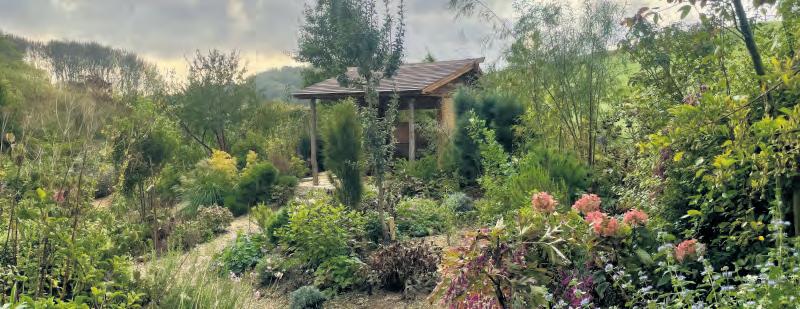
St Andrews Street, Wells, Somerset BA5 2UR
Seen on the cover of the Somerset NGS 2024 booklet, it’s one of the few houses in England that can boast a cathedral and a sacred well in its garden, opening for the National Garden Scheme on Saturday 22nd June, 12pm-5pm. Compact, with long established trees, interesting shrubs, mixed borders, ancient walled orchard and traditionally planted cottage garden. Admission £6, children free.
Symondsbury, Bridport, Dorset DT6 6HH
A new opening for the NGS on Sunday 2nd June,1pm-5pm, set in the Dorset countryside, the half acre garden is an intricate web of gravel paths weaving between deep and colourful borders, with extensive collection of new and unusual plants, especially Itoh peonies and hydrangeas; Japanese styled koshi-kake ‘waiting room’, surrounded by dwarf pines, grasses and ferns. Admission £6, children free.


Stoke Gabriel, Totnes, Devon TQ9 6RL
Opening for the NGS on Saturday 8th and Sunday 9th June, 11am-5pm each day, high above the River Dart, the Sandridge Park Estate has a Nash villa of 1805, formal gardens and ponds, a newly-built walled kitchen garden and orchard, and lawns overlooking the river; extensive collection of
roses and specimen trees, a fern garden and woodland walks along the banks of the Dart.
Admission £6, children free.
Nympsfield, Stonehouse, Gloucestershire, GL10 3UN
Masses of roses and summer planting in this elegant, partially walled garden of about three acres that opens for the NGS on Sunday 30th June, 12pm-5pm, displaying extensive herbaceous borders, a yew walk, a rose covered belvedere overlooking a large pond, a woodland garden, rose walk, vegetable garden and terrace. Admission £6. children free.
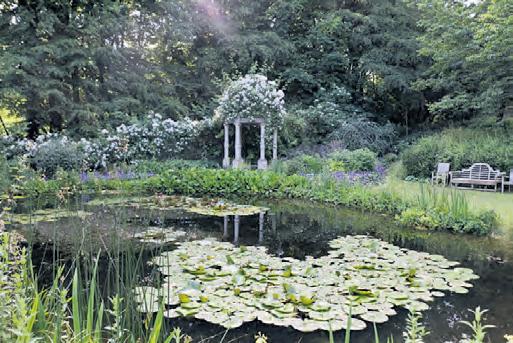

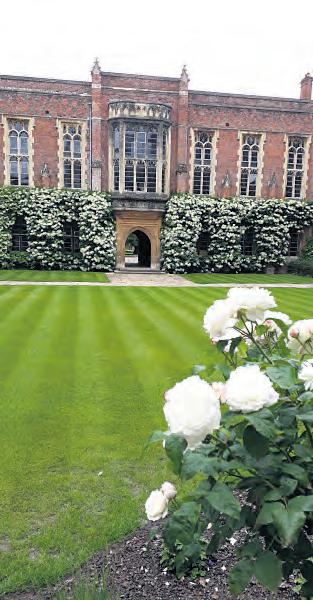

Conock, Devizes, Wiltshire, SN10 3QQ
A new opening for the NGS on Saturday 8th June, 11am-4pm, a relaxed family garden embracing 18th century architecture (including a rustic dairy) and defined by its long, south facing wall; lawns and wildflower meadows, mixed borders, climbers, magnolia grove and vegetable garden with greenhouse, and a ha-ha; wooded parkland with views out to the hills and the Alton Barnes chalk-horse. Admission £8, children free.
Avon Castle, Ringwood, Hampshire, BH24 2BH
Athelhampton, Dorchester, Dorset DT2 7LG
Opening for the NGS on Friday 21st June, the awardwinning Grade I architectural gardens surround the Tudor manor house, and date from 1891. The Great Court with 12 giant yew topiary pyramids is overlooked by two terraced pavilions, spectacular planting, ponds with fountains and the River Piddle flowing past. Admission £12.50, children free. Open 10am-5pm, garden only, but tickets for the house can be bought on the day.
College Street, Winchester, Hampshire, SO23 9NA
See the historic gardens of Winchester College, the main quad with herb garden, herbaceous borders and splendid climbing hydrangea; War Cloister designed by Herbert Baker, Bethesda a soft cottage style garden; Meads, a stunning walled cricket ground surrounded by magnificent plane trees; and the Warden’s Garden with Regency border, chalk stream and wilder woodland area. Opens for the NGS on Saturday 1st and Sunday 2nd June, 11am-4.30pm. Admission £10, children free. https://www.winchestercollege.org/visit-us
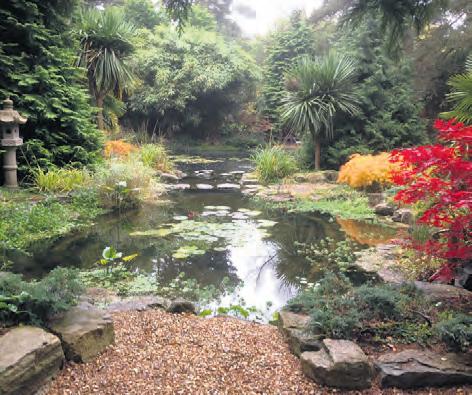
A fine Japanese themed water garden opening for the NGS on Sunday 16th June, 12pm-5pm (also 28th July and 25th August). See the granite sculptures, ponds, waterfalls, azaleas, rhododendrons, cloud topiary and a collection of goldfish and water lilies. Children must be under parental supervision due to the large, deep water pond. Admission £5, children free.

Church Lane, Dauntsey, Malmesbury, Wiltshire, SN15 4HT
A group of seven gardens centred around the historic Dauntsey Park Estate, open for the NGS on Sunday 16th June, 1pm-5pm, ranging from the classical 18th century setting of Dauntsey Park, with spacious lawns, old trees and views over the River Avon, to mature country house gardens and traditional walled gardens, a formal rose garden, old fashioned borders and duck ponds, a quiet secluded garden with its thyme terrace and gazebos, climbing roses and clematis, traditional walled kitchen garden, orchard, woodland walk and yew topiary and a two-acre garden adjoining the River Avon with mature trees, roses and shrubs. Combined admission £10, children free.
Vine Lane, Sutton, Tenbury Wells, Worcestershire, WR15 8RL
An award-winning country garden surrounding 16th century farmhouse (not open) on a working farm, the garden opens for the NGS on Sunday 16th June, 11am-4pm. Herbaceous borders, roses, box-parterre, productive kitchen and cutting garden, spring garden, wildlife pond and a ha-ha allowing wonderful views. Walkers and dogs can enjoy numerous footpaths across the farm land. Admission £5, children free.
Church Hill, Pinhoe, Exeter EX4 9JB
Opening for Hospiscare on Sunday 16th June from 11am until 4pm, a large garden with far reaching views of the River Exe to the sea, large herbaceous borders, many seated areas in the sun and shade, as well as an ornamental pond and large lawn. Also on display, a collection of classic cars and motor bikes. The owner will be on hand to answer all questions. Admission by donation. Parking in the nearby field. www.hospiscare.co.uk/gardens
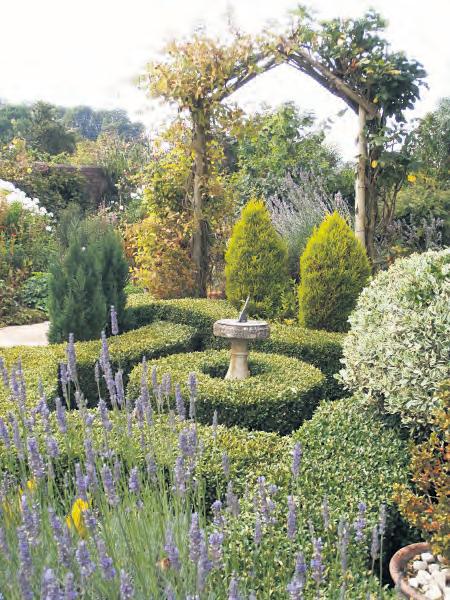
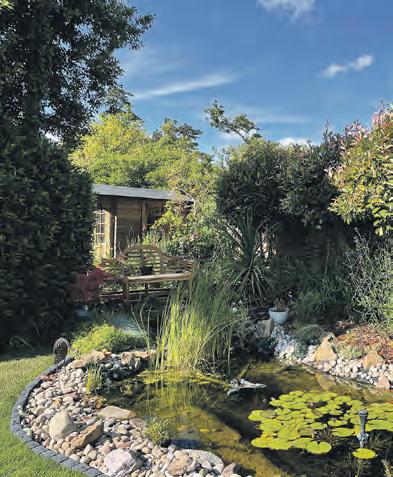

Farnborough, nr Wantage, Oxfordshire, OX12 8NX
Opening for the NGS on Wednesday 26th June from 2pm until 5pm, a garden of immaculately tended garden rooms with herbaceous borders, an arboretum, a secret garden, roses, vegetables and bog garden. Explore and discover an explosion of rare and interesting plants, beautifully combined for colour and texture. Admission £5, children free. Also opening for the NGS on Wednesday 31st July.


Cowleigh Road, Malvern, Worcestershire, WR13 5HJ
Opening for the NGS on Friday 14th June from 2pm until 5pm, the 1½ acre garden surrounds a Grade II listed timber framed former farmhouse (not open). Whilst no longer a farm, the property has views to adjacent orchards and includes lawns, spring fed ponds, a waterfall and stream; wildlife and bee-friendly, there’s multiple seating areas and a summerhouse. Admission £6, children free.
Burnt Oak, Sidbury, Sidmouth, Devon, EX10 0RE
A new opening for the NGS on Friday 21st and Sunday 23rd June, the gardens and grounds of Sidbury Mill (still producing flour from adjacent fields) extend to six acres, a wildlife haven with a perennial, rose and shrub garden, a greenhouse and vegetable patch, and mature woodland through which the River Sid flows. Admission £5, children free, open 11am-4.30pm both days.
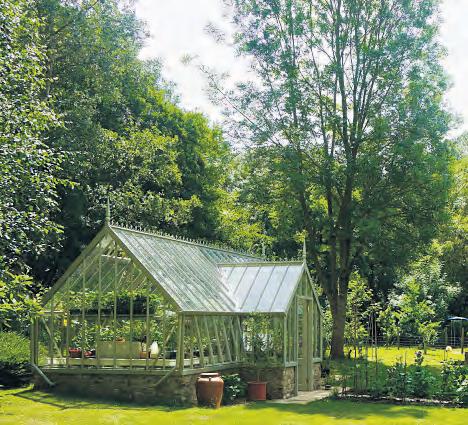










Our popular gardening themed crossword is compiled by Saranda which over the past year has become enormously popular with readers. The winning entry to be drawn by us will receive £100 of RHS gift tokens. Completed entries should be sent to Mount House, Halse, Taunton, Somerset TA4 3AD. Closing date Friday 21st June. The April issue winner was Lia Flantz from Exeter.

Garden clubs and associations are starting to fill up their events calendar for the new season. If you would like to share club events then take advantage of our traditional free service which lists events, meetings and outings.
Send your information to timeoff@countrygardener.co.uk
30TH
Budleigh Salterton Garden Club ‘GRASSES’ - KATHERINE CROUCH Details on 01395 445840
Exmouth Garden Club ‘ODD THINGS THAT HAPPEN WITH PLANTS’ - TIM ELLIS Details on www.exmouthgardenclub.co.uk
ACROSS
1. Season to which John Keats dedicated his famous ode (6)
4. Large farming implement that turns soil (6)
8. Tropical plant Sesamum indicum (6)
13. Regretting bitterly (6)
14. Common name of Campanula medium (10, 4)
16. Valerianella locusta or corn salad (5, 8)
17. Family of flowering plants commonly known as mint or sage (8)
18. Cranford author, Elizabeth _______ (7)
19. Provencal dish of stewed vegetables including aubergines (10)
22. Common name of Pinus pinea (8, 4)
23. An emperor of Russia, pre-1917 (4)
27. Any of a number of North American conifers, particularly the tamarack (10)
29. Prefabricated steel structures originally for military use (6, 4)
31. Wild dagga or ____’s tail, a species of the mint family (4)
32. Genus of flowering plants commonly known as figworts (12)
37. Being worked on or currently undergoing restoration (5, 6)
38. Tropical American tree from whose fruit a dye is obtained (7)
40. Genus of plans in the staff vine family (8)
41. A place where fruit and veg are grown for sale (6, 6)
43. Sum of money needed to start a business (7, 7)
44. Small Yorkshire town famous for its moor (6)
45. An Australasian tree or flowering shrub (2, 4)
46. An Australian acacia tree with fernlike leaves and yellow flowers (6)
47. Oliver’s favourite dances? (6) DOWN
1. The application of science to agriculture (8)
2. Lichen that grows on woody trunks and branches (4, 4)
3. Moonseed plants (12)
5. A shed or shack (4, 2)
6. Relating to nettle rash (10)
7. Any seed-bearing plant without a woody stem (4)
9. Wallflower genus (8)
10. Widely cultivated plant Lobularia maritima (5, 7)
11. Silene chalcedonica, flower of Bristol or nonesuch (7, 5)
12. Common name of members of Cercis siliquastrum (5, 5)
15. Person who cuts down trees (6)
20. Common wheat belongs to this genus (8)
21. Genus of grasses known commonly as mannagrass or sweet-grass (8)
24. A collector of matchbox labels (12)
25. Musician such as Jimmy Shand (12)
26. Common name of Abutilon indicum (6, 6)
28. Artistically and pleasingly (10)
30. Bur-reed genus (10)
33. Greek prefix meaning having thornlike characteristics (6)
34. In mineralogy, same as argentite (8)
35. Stones, sometimes resembling mushrooms, used as supports for hayricks (8)
36. Matilija poppies or fried egg flowers (8)
39. Daggers formerly used in Scotland (6)
42. Sweet-smelling oil obtained from tropical trees (4)
Answers from previous issue, May 2024:
2ND
Southleigh OPEN GARDENS In aid of The Seaton Hospice 12noon - 5pm
5TH
Brigham Horticultural Society MONTHLY MEETING Details on 01803 842121
6TH
Plympton Gardeners Association ’45 YEARS A SEED AND PLANTSMAN’ - TOM SHARPLES Details on 01752 336057
11TH
Axminster Gardening Club ‘THE EXTRAORDINARY ELDERFLOWER’ - LORI SHUTE Details on 01392 832762
17TH
Meavy Garden Society ‘PRINCIPLES OF GARDEN DESIGN’JACQUIE FELIX Details on 01822 852672
19TH
Torquay and District Garden Club ‘SEASIDE GARDENS’ - CARADOC DOY email: nickibaker222@gmail.com
27TH
Budleigh Salterton Garden Club ‘ROSES’ - CLAIRE FORSTER Details on 01395 445840
29TH/30TH
Newlands Farm, Chittlehamholt OPEN GARDEN 11am - 4pm / 7.30pm - 10.30pm: Night Garden Are you part

Please send us your diary for the year - we’d love to include your talks and shows
Send them into us by email giving us 10 weeks notice of the event: timeoff@countrygardener.co.uk or by post to: Mount House, Halse, Taunton, TA4 3AD.


SIEVED COMPOST, MUSHROOM COMPOST, ORNAMENTAL BARK AND WOOD CHIP £3 SMALL BAG £85 DUMPY BAG
Topsoil farmyard manure, horse manure, wood chip mulch and chicken manure
£2.50 small bag £75 dumpy bag BULK ORDERS CAN BE MIXED


Example 1/3 topsoil 1/3 manure 1/3 compost Great for raised beds
Topsoil and compost is sieved or screened producing a lump free stone free product

The new Husqvarna NERA robotic mowers can be installed with or without boundary wires*. They are suitable for large and complex lawns and are equipped with the latest intelligent technologies such as object avoidance.
www.connettscompost.com





ACCOMMODATION
Secluded cosy cabins & lodges in wooded valley running down to Wembury Bay & SW Coastal Path

Plymouth, Dartmoor & lovely South Devon Villages & Towns in easy reach. Pets Welcome. Forest School. Tel: 01752 862382 www.churchwoodvalley.com

Carmarthen Bay South Wales Seafront chalet situated on estuary. Sleeps up to 6. Seaview. Well Behaved Dogs Welcome Free of Charge. Free WIFI. Open from 1st March - 31st Dec. For Brochure
Tel: 01269 862191
NORTH DEVON. THE POTTING SHED. Sleeps 2. Set in a beautiful walled garden. Close to RHS Rosemoor. Call Mary on 07811 425278
GLORIOUS NORTH DEVON. Only 9 cosy caravans on peaceful farm. Wonderful walks in woods & meadows. Easy reach sea, moors & lovely days out. £125-395pw. Discount couples. Nice pets welcome. 01769 540366 www.snapdown.co.uk
BOSWORLAS, ST JUST. Cosy Cottage sleeps 2-4. Please email info@bosworlas.co.uk for availability
ACCOMMODATION HOLIDAY COTTAGES
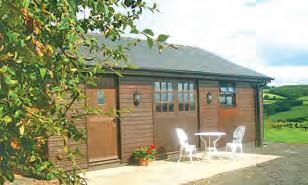
Peace, Privacy, and Stunning Views!
4* Delightful cosy cabin for 2, nestling between Wye and Usk Valleys. Shirenewton village & pubs close by. Wonderful walks, splendid castles, bustling market towns. Perfect for all seasons!
Tel: 01291 641826
Email: lynne@bryncosyn.co.uk www.bryncosyn.co.uk
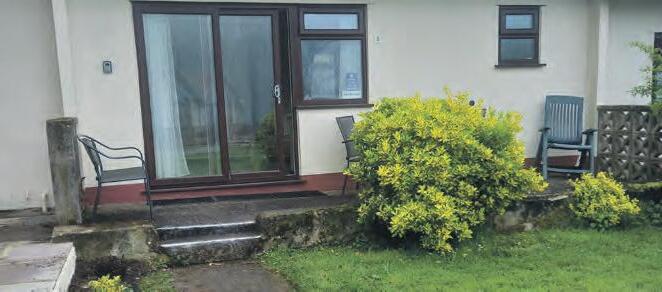

Gloucestershire Quality Bungalow B&B


HOLIDAY COTTAGE SIDMOUTH, DEVON
A quiet holiday bungalow near Sidmouth, overlooking the Donkey Sanctuary. Ideal for walkers and nature lovers. Sleeps 4. Bookings from April to the end of October.
jandtmercer@gmail.com www.sandwaysholidaycottage.co.uk 07842 514296 SANDWAYS
WYE VALLEY/FOREST OF DEAN. Fully equipped single-storey cottage with two en-suite bedrooms. Wi-fi.Recently awarded Visit England 4-star GOLD. Rural retreat, shops/pubs one mile. Enquiries welcome. AS SEEN ON ESCAPE TO THE COUNTRY! Tel: 01594 833259 www.cowshedcottage.co.uk
ACCOMMODATION WITH BEAUTIFUL GARDENS

Near Stratford-upon-Avon
Lovely self-catering cottage in peaceful location: large garden. Sleeps 2. Perfect for famous gardens, NT properties & Cotswolds. Tel: 01789 740360 www.romanacres.com

NORTH DEVON NEAR CLOVELLY. 3 delightful cottages situated in 12 acres of idyllic countryside. Sleeps 2-4. 1 Wheelchair friendly. Brochure: 01237 431324 www.foxwoodlodge.co.uk foxwoodlodge@outlook.com
Want this space?
ADVERTISE HERE FROM JUST £2 PER WORD
Email: classified@countrygardener.co.uk for more details
Ensuites, rural, large garden, paddocks, sheep and fruit. Ideal Cotswolds, Malvern’s, Forest of Dean, cycle storage, ample parking, Wi-Fi £42 p.p.p.n. Tel: 01452 840224 sheila.barnfield1960@gmail.com

A range of over 200 greetings cards and prints from the flower paintings of ANNE COTTERILL We sell to both individuals and trade. No order too small. Contact us for your free catalogue.
Mill House Fine Art Publishing, Bellflower Gallery, Market Place, Colyton, Devon EX24 6JS
Tel. 01297 553100 info@millhousefineart.com www.millhousefineart.com


jonne@jonne.co.uk 07770 720 373
Artist blacksmith based near Axminster designing and manufacturing garden plant supports, structures, garden art and fine art bronzes. Commissions welcomed. www.thegardenersblacksmith.co.uk
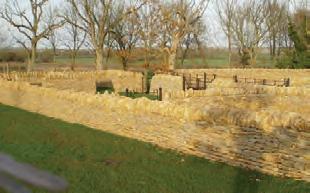
Yenstone Walling
Dry Stone Walling and Landscaping
Patrick Houchen - DSWA member
Tel: 01963 371123 www.yenstonewalling.co.uk

01363 84948 info@ferrymanpolytunnels.co.uk www.ferrymanpolytunnels.co.uk

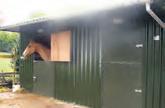
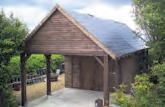
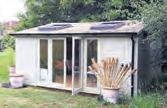








Cat & Fiddle Park
Near to the magnificent River Exe estuary and the fringe of an area designated of outstanding natural beauty, the Cat and Fiddle Park is a short distance from the beautiful cathedral city, Exeter. With 1 park home available today starting at £185,000.
Glenholt Park
Glenholt is an established and sought after location approximately four miles north of Plymouth city centre. The area is largely flanked by woodlands that provide pleasant walks to Plymbridge. With 1 park home available today starting at £147,000.
New Park
This beautiful park is situated on the outskirts of Bovey Tracey, a typical small Devon town with good shopping facilities. The Park features mature woodland, large lake and views of the rolling hills of Dartmoor. With 1 park home available today starting at £262,000.
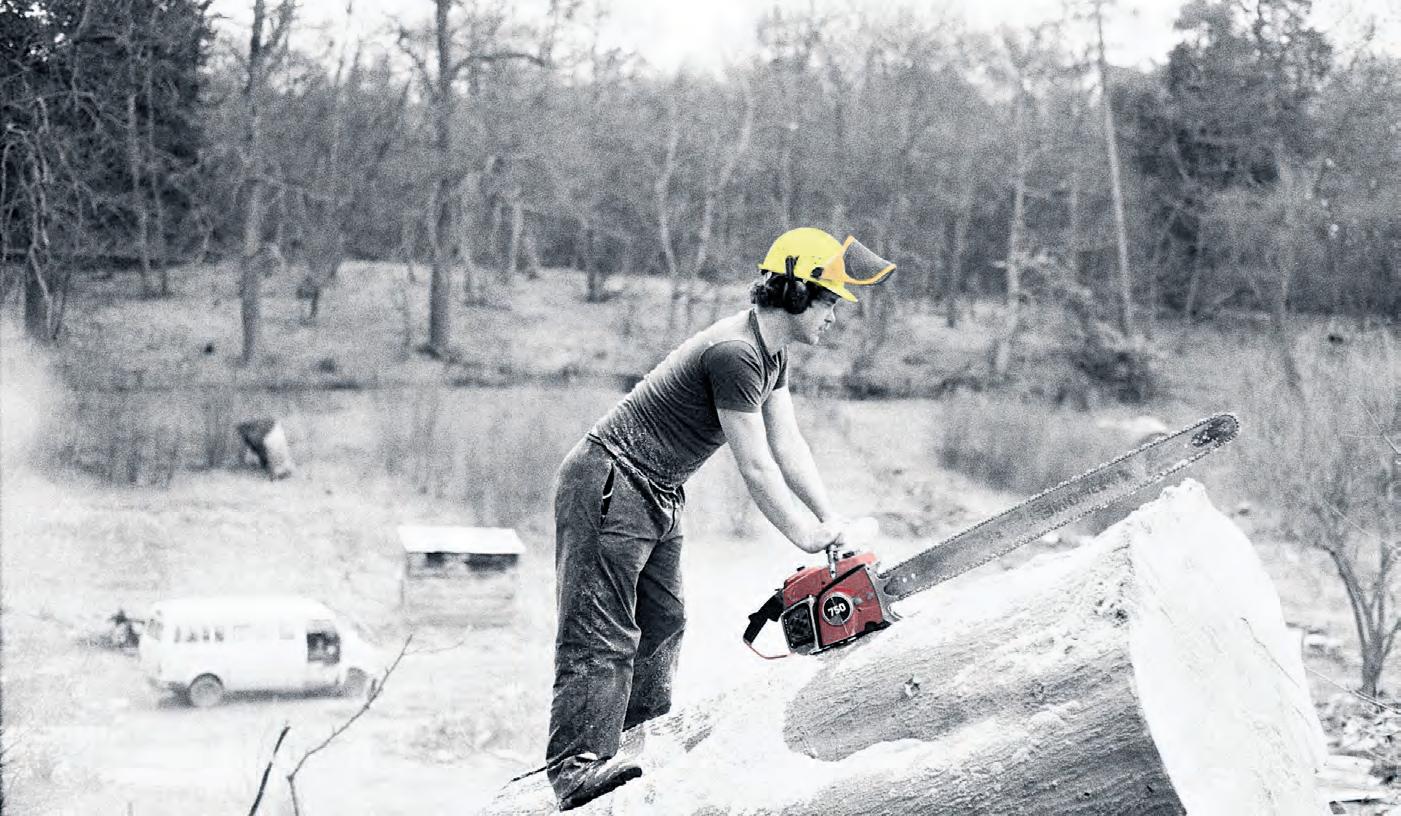
Mark Hinsley is in reflective mood as he looks back on 30 years of advising and observing arboriculture and notes how it has evolved into a science – and that the then Prince of Wales was right with his views on trees.
It was 1994, I sat in my new office, an Amstrad computer on my desk loaded up with Open Access 4 an MS DOS WORD Processing package, new phone beside me. Mark Hinsley Arboricultural Consultant was launched upon an unsuspecting public and I’m thinking “You’ve done it now, mate. You are going to sink, or you are going to swim”.
Thirty years later I am still paddling!
In that time, I have driven the equivalent of 28 times around the world. I have worked in Liverpool, Nottingham, Stirling (Scotland), Stalham (Norfolk Broads), Chelmsford, Canterbury, Ventnor (Isle of Wight), Redruth, Weston-super-Mare, Rhayader (Wales) and all points between.
Nineteen people have worked for me – four great people still do I have witnessed arboriculture evolve from a practice into a science. It has reached the point where most of what we were taught as students, a further 20 years earlier at Merrist Wood College near Guildford, which at the time was considered world beating, has turned out to be little better than witchcraft. And most of the tree surgery equipment we used is banned on the grounds of it being too dangerous.
Looking back – it probably was!
One dramatic change is how we handle site plans and drawings for planning applications. When I started, we used to receive an A1 sized printed plan which we had to trace by hand. We then added onto the tracing all the tree survey information, location, tree number, canopy spread. That tracing was put through a dyeline printer, the smell of which really cleaned out your sinuses. The final, bluish print was then coloured where necessary by hand with coloured pencils to highlight tree information. Finished plans were rolled into long cardboard tubes and sent by post.
Editorial Publisher & Editor: Alan Lewis alan@countrygardener.co.uk Tel: 01823 431767
Time Off Kate Lewis timeoff@countrygardener.co.uk
Nowadays, computer programmes do most of that and plans are rarely printed larger than A3 if they are printed at all. Information is all shared electronically and the specialist stationery shops have largely gone.
Attitudes to trees and the environment have changed dramatically over the last 30 years. They used to mock the then Prince of Wales for his views on trees and the environment. They are not mocking King Charles III now because he was right on many levels.
Dis-information about trees has always been a problem. The head shaking, teeth sucking brigade, who basically market fear, were ripping people off then as they still are now. Unfortunately, the massive expansion of social media has not helped. Now everybody is an expert and some people do not let total ignorance of the subject stand in the way of a strongly held opinion.
As our scientists are teaching us just how complex tree relationships with other trees, fauna, fungi and bacteria really are, the social media world is trying to digest everything down to short sentences and sound bites. It cannot be done accurately – so they spin rubbish.
I must be getting old – I shout at the television too much.
One advert really makes my blood boil. A company which sells a paper product proudly announcing that it plants four trees for every one it fells, as if that was unusual. In fact, that is standard forestry practice. You fell a plantation for the paper mill. You plant four times, or more, new trees in the area cleared, you grow them on, you thin them out a couple of times and eventually you fell the crop for the papermill. You do this in blocks in rotation across a whole forest.
Then you pretend it is something special in an advert.
Mark Hinsley, of Mark Hinsley Arboricultural Consultants Ltd, offering tree consultancy services. www.treeadvice.info
Advertising Sales Ava Bench - Somerset & Hampshire ava@countrygardener.co.uk Tel: 01278 786139
Cath Pettyfer - Devon cath.pettyfer@countrygardener.co.uk Tel: 01837 82660
Corina Reay - Cotswolds & Dorset corina@countrygardener.co.uk Tel: 01823 410098
Classifieds classified@countrygardener.co.uk
Accounts and subscriptions Heather Rose heather@countrygardener.co.uk
Design & Production
Aidan Gill aidan@countrygardener.co.uk
Gemma Stringer gemma@countrygardener.co.uk
Distribution & Stockists distribution@countrygardener.co.uk



